Jack has been interested in computers and tech since 10 years old when he decided to dismantle his PC to see how it worked. Ever since Jack has had a passion for IT and gaming beyond any other. He loves the data and testing process and allowing himself to take an analytical and technical approach to PC hardware. He's even gone as far as getting educated in cyber security.
WePC is reader-supported. When you buy through links on our site, we may earn an affiliate commission. Learn more
Last Updated:
We analyze almost everything you can think of when it comes to both AMD and Intel, including market shares, sales, CPUs, and more. All of this to determine who is better, AMD vs Intel?
Choosing the right CPU is one of the most important decisions you will make when building your dream PC. This decision affects both the potential performance of your PC, and the components you can subsequently equip it with.
In this article, we will take a deep dive into both AMD and Intel, not just as CPU manufacturers, but as companies. We will examine market shares, company profits, year-on-year growth, and more.
With that being said then, AMD or Intel, which is better?
Comparing AMD and Intel
Before we dive in, let’s take a look at how we’re going to be comparing the two CPU titans.
- Understanding CPUs – This will be a rundown of how CPUs work, and why they are important in modern-day computing.
- SKUs, specifications, and price – Examining each of the latest lineups of CPUs each manufacturer has to offer.
- Performance – A closer look into how certain AMD and Intel processors stack up against one another.
- Overclocking – Which processors offer the most when it comes to overclocking.
- Upgradability/Longevity – Which processors are here to stay?
- Availability and support – A look at product availability and compatibility.
- AMD Vs Intel – A look at market shares, sales, and growth figures for each company.
- Brand speculation – What’s on the cards next for AMD and Intel?
Understanding CPUs: What is a CPU?
To kick off this absolute behemoth of an article, we answer the question, “What is a CPU?”.
CPU stands for central processing unit and describes exactly what the CPU is. It’s the main or ‘central’ unit or component where the computing or ‘processing’ takes place. Easy, right? Well, although the concept of a CPU is easy to understand, the object itself and how it operates can be a little trickier to understand.
A CPU can be thought of as the ‘brain’ of your computer, as it’s the component that undertakes all of the ‘thinking’. In simple terms, the CPU is electrical circuitry that executes instructions and commands that comprise computer programs and software. The CPU sits in the motherboard inside a special socket made specifically for that CPU’s pin or pad configuration – more on motherboards later.
How does a CPU work?
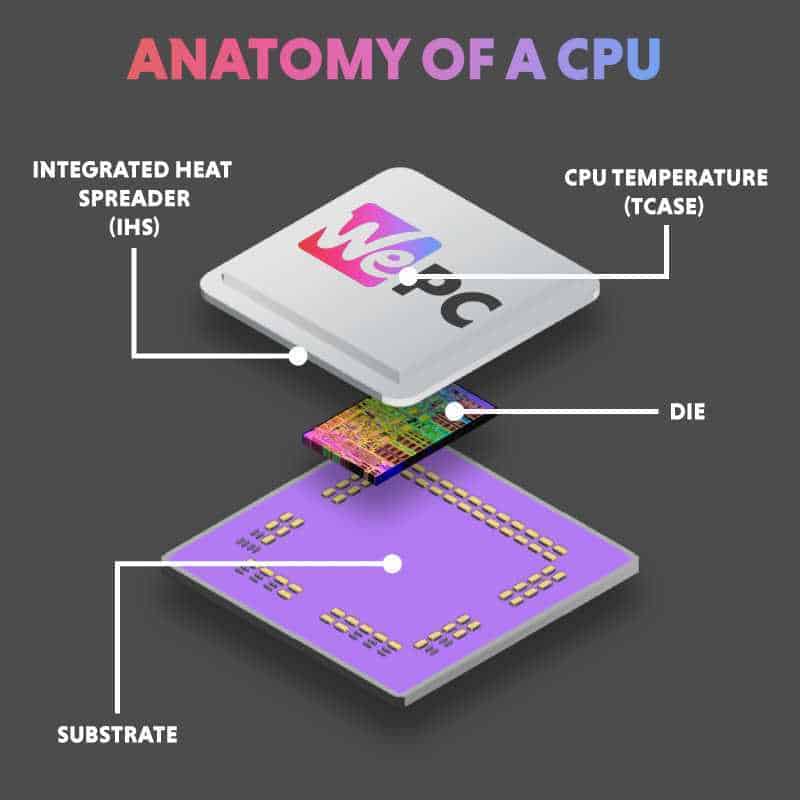
A CPU carries out instructions set by computer programs. These programs are loaded temporarily into RAM. The CPU then makes calculations using its logic gate transistors and determines a string of ones and zeros. This process is known as the CPU instruction cycle and is broken down into three simple steps, Fetch, Decode, and Execute. These three actions are what comprise the fundamentals of computing as we know it, so this process is imperative to all PC operations.
Understanding the acronyms
Since we feature CPUs heavily as a point of comparison in this article, it’s important to understand what some of the following terms and acronyms mean. It will also be helpful to know these for the performance and CPU comparison portions of the article.
With that being said, let’s dive in.
Cores and threads
CPU cores and threads were very easy to wrap your head around until Intel ruined it.
Intel, in its 12th-generation CPUs, incorporated ARM’s LITTLE.big technology into its desktop processors. This means that Intel now features two types of processing core in its CPUs – one type being the ‘performance core’ that handles all the heavy lifting, and the other type being the ‘efficiency core’ for better power consumption.
We now refer to these split CPU cores as ‘E-cores’ and ‘P-cores’. We will expand more upon this later in the article.
Intel shenanigans aside, CPU cores are what process the instructions sent to your CPU by programs. The more CPU cores a CPU has, the better at multitasking that CPU will be.
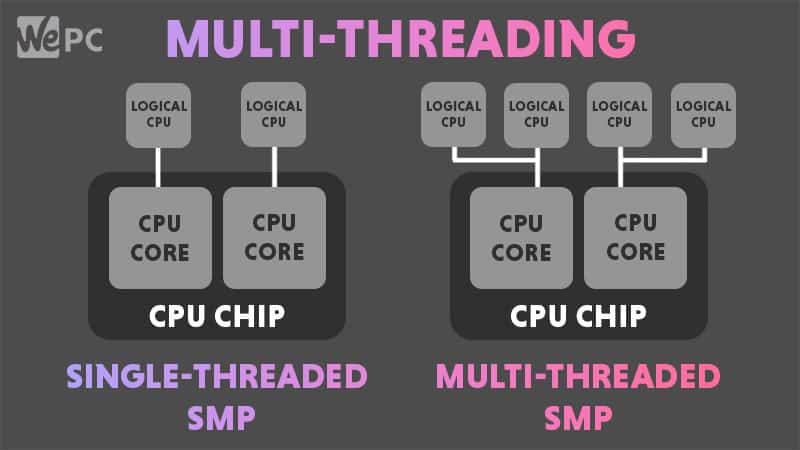
Threads differ slightly from CPU cores but can be thought of in the same manner. Threads are the ability given to CPU cores through multithreading technology to process two instructions simultaneously, as opposed to one. The presence of multithreading almost doubles the potential output of the CPU, but not quite.
However, threads are not created equal. Since threads are virtual and don’t occupy any space on the CPU die, they have to share resources with the CPU cores – making them slower as a result.
Your operating system indiscriminately groups both cores and threads together and labels them ‘logical processors’, as both can perform an instruction cycle.
Clock speed
There are usually two types of clock speed when referring to CPUs, we have ‘base clock speed’ and ‘boost clock speed’. Both of these are measuring the same thing, the speed of a CPU core, just at different stages.
Base clock speed
Base clock speed is the lowest expected frequency of a CPU core. For example, if a CPU’s base frequency is 3.2GHz, you would expect to be constantly achieving a core speed of 3.2GHz.
Boost clock speed
Boost clock speed is the exact same as the base clock speed, only this is measured when the CPU core is being boosted automatically by either Intel or AMD’s proprietary core boosting technology. The Boost clock speeds get a little more complex when we throw in the ‘all core boost speed’.
All core boost speed is the speed all CPU cores can achieve simultaneously. This differs from boost speed, which usually refers to the maximum speed any one core can achieve at any given time. CPUs only have a finite amount of power and can delegate between CPU cores. While a CPU may be able to boost all the way up to 5.2GHz on one or two CPU cores, that does not mean it is able to do this on all cores, because of its power constraints.
All-core boost speed is usually a couple of hundred MHz lower than the maximum boost speed, so if a CPU has a boost speed of 5.1GHz then the all-core boost speed maybe somewhere around 4.9GHz.
IPC and clock speed
Core speed is important for performance and IPC (instructions per cycle). This is the number of instructions a CPU can execute every CPU cycle. This ‘cycle’ refers to the instruction cycle that consists of three actions, fetch, decode, and execute.
A CPU clock speed is how many instruction cycles a CPU can perform every second and since it’s measured in gigahertz (GHz) we’re talking about billions of instructions every second. Not all core speed was created equal, however. If a CPU belongs to an architecture with a smaller nm process like 7nm vs 12nm, the 7nm process will have a higher IPC as the transistors used in its composition are much smaller, meaning more are present within the CPU itself.
This shows that CPUs with smaller transistors allows more of them to be loaded into the same footprint, meaning the CPU with a 7nm process is capable of more computations per cycle. This means that one of the 7nm process CPU cycles is worth more than one of the 12nm process CPU cycles.
So, even if both CPUs had the exact same clock speed, the CPU with the 7nm process would be more powerful as it has a higher IPC. The more transistors you have, the stronger your CPU is.
There’s a lot to take in here and we explain these subjects in far more detail in our ‘5800X vs 5800X3D’ article.
TDP
TDP stands for thermal design power and is a measure of how much thermal energy the component can output under normal operating conditions, excluding overclocking.
Power enters the CPU as it does every electrical component, and a bi-product of this electrical transference is heat energy. Heat is generated as energy is transferred between components of the CPU, but a good portion of the energy is wasted and given off as heat.
You should always get a CPU cooler that is capable of dissipating a TDP measurement higher than your current CPU’s output, the higher the better. You need to maintain a viable temperature to get the most out of your CPU, in terms of performance and longevity.
When overclocking your CPU, heat is your biggest enemy. All the extra heat generated by the increased power and workload needs to be dissipated. This is why it’s important to pick up a cooler that gives you plenty of headroom.
A higher TDP is usually indicative of a more powerful CPU, but you need a better cooling solution to keep it working as it should.
Socket
Sockets are perhaps the simplest part of CPUs. A socket is a component on the motherboard in which the CPU sits. It’s important to ensure you pick up a CPU that will fit in your motherboard’s socket – this can be easily found in both the motherboard and CPU product specifications.
A socket can be thought of as a shape, and only a CPU with a matching shape will fit into it.
Price and specifications
Here we will examine the price and specifications of a select set of AMD and Intel CPUs, which will help us determine the broader value of each company’s processors, and just how much your hard-earned money gets you when it’s given to either of these CPU giants.
As a general rule, AMD’s processors are less expensive. Not only that, but AMD technically holds the record for the fastest gaming CPU with its 5800X3D. The 5800X3D managed to surpass the 12900KS, Intel’s latest flagship CPU, in some gaming scenarios.
If you’re interested, we delve more into the 5800X3D in our Ryzen 7 5800X3D review.
So, if AMD is faster as a whole and generally cheaper, then we have a winner, right? Well no, it’s not quite so clear-cut. Let’s take a closer look at some of AMD’s CPUs and their Intel counterparts.
Let’s take a look at the two current CPU flagships, the Ryzen 9 5950X and the Core i9 12900KS.
5950X vs 12900KS
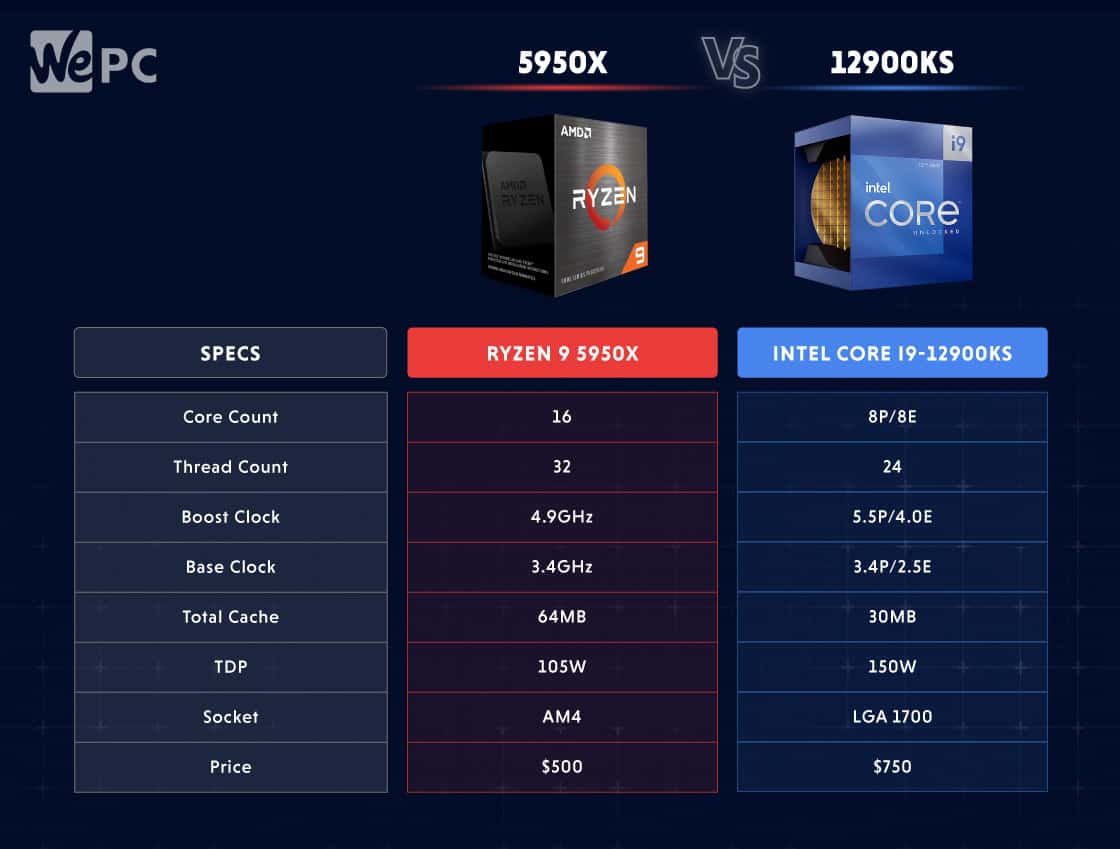
Both the 5950X and the 12900KS are incredible processors, but there are clear differences in how they operate that define them, leading to massive performance differences in some cases.
As we previously mentioned, Intel’s 12th-generation CPUs are built upon ARM’s LITTLE.big technology, splitting the CPU into P-cores and E-cores. The 5950X does not contain such technology, so its cores remain uniform. Because of this division of cores, the 12900KS has more power overhead to pump into its performance cores, allowing for its 5.5GHz max boost speed.
Despite Intel’s recent efforts to increase CPU efficiency, the 12900KS still has a 45W higher TDP than the 5950X – totaling a huge 150W. The 5950X, with its eight additional threads, manages a TDP of 105W.
When it comes to computing, having a strong cache is just as important as having CPU cores. The 5950X manages to pack almost double the cache of the 12900KS onto its die, that’s twice the stored and qued instructions ready for execution – lowering latency and increasing speed.
You’d think that with the 5950X having more threads, almost twice the cache, and a lower TDP, the 5900X would be magnitudes more expensive than the 12900KS – but it isn’t.
The 5950X is around $250 less than the 12900KS, but it is older.
We’re still waiting for AMD’s response to Intel’s 12th-generation CPUs. That response is coming in the form of Zen 4 Raphael CPUs – more on that later. But if AMD can pack this much of a punch into a CPU that is a generation behind, then we can’t wait to see what the next generation of AMD CPUs can do.
We have a review of the 12900KS, you can check it out here.
With the flagships out of the way, let’s jump more towards mid-level processors.
5800X3D vs 12700K
Okay, admittedly the 5800X3D isn’t exactly a mid-level processor, as it holds the title of the world’s fastest gaming CPU. This is all thanks to AMD’s 3D V-cache – the 5800X3D is the only desktop processor to feature this caching technology.
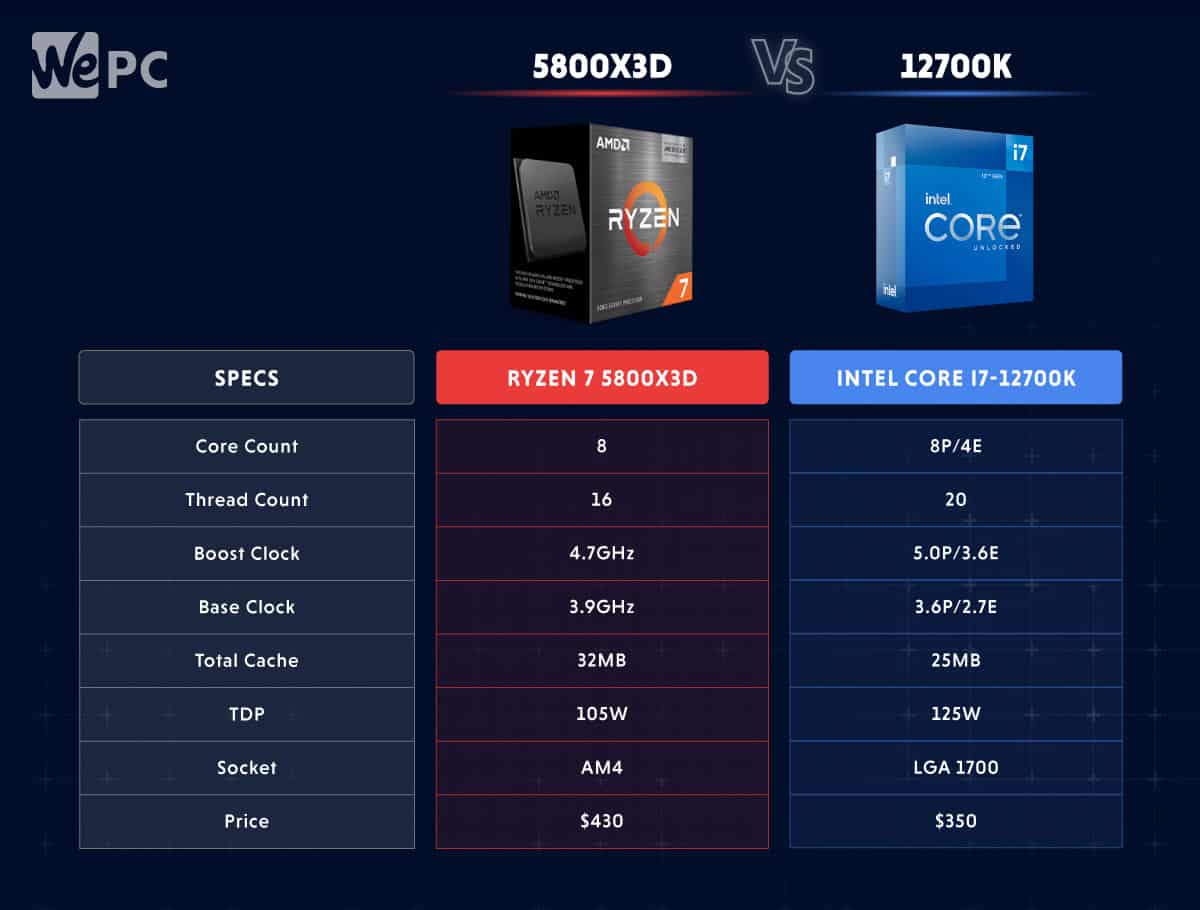
Technically speaking though, in terms of specifications the 5800X3D is pretty mediocre, and at a first glance would be a good match for something like the 12700K – however, looks can be deceiving. This example serves as a reminder that the CPU industry is ever-changing, and it’s not quite as easy as it once was to analyze CPU specifications and come out with a clear winner.
The 12700K has four more threads than the 5800X3D and four more processing cores. This makes the 12700K the better processor, right? Wrong, the 5800X3D has a huge advantage over the 12700K thanks to its 3D V-cache, despite its shortcomings in core speed, core count, thread count, and TDP.
The 3D cache is stacked vertically as opposed to laterally, all thanks to recent technological advancements in 3D printing.
Stacking the cache shiplets vertically drastically increases the number you can fit into one footprint, without compromising speed or efficiency. This vertical cache stacking has allowed AMD to pack 96MB of total L3 cache with access speeds of up to 2TB/s into the 5800X3D.
This technology increases the amount of cache present and decreases cache latency, making for a better CPU overall.
It seems as though AMD has the upper hand, even at the lower end of current-generation processors.
5600 vs 12400
On paper, these two CPUs seem incredibly similar, with the only real differences being in cache, and base clock frequency.
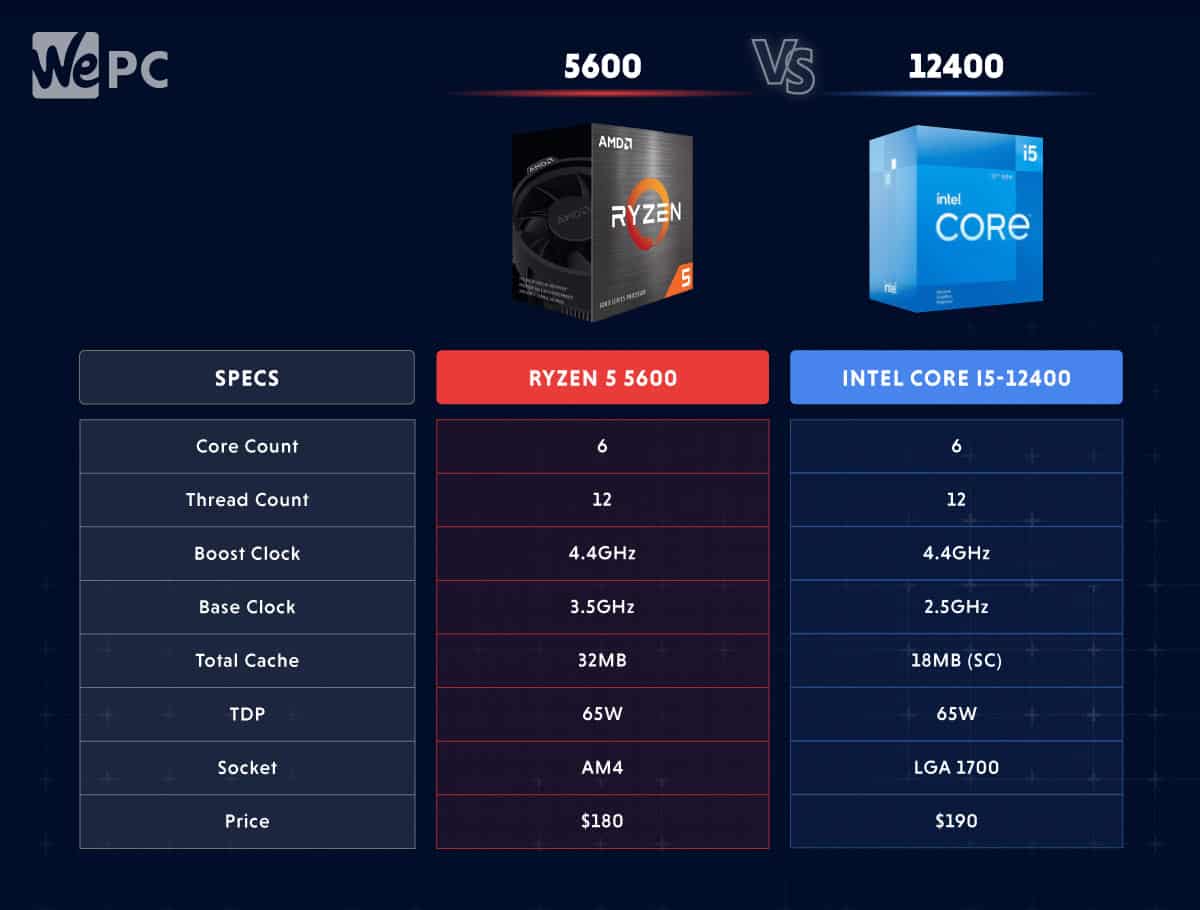
Both are priced at around $180, making them the ideal ‘budget’ CPU. The 5600, with its larger cache, outperforms the 12400 in most cases.
That being said, however, single-core performance is something the 12400 shines at, always scoring higher in single-core synthetic benchmarks. There’s not too much to say about these CPUs, as they’re incredibly similar, but there’s still a performance difference between the two. AMD almost always outperforms Intel in multi-core workloads, and Intel almost always nips the top spot in terms of single-core performance.
The value of AMD
AMD seems to be aiming for the multi-core performance side of computing, and if it can do that at a lower price point than Intel then it will, as it has proved time and time again.
You can expect an AMD CPU to be efficient, easy to cool, and dominate in the multi-core performance aspect of computing. Every AMD CPU generation gains ground towards taking the top spot from Intel, both in single and multi-core performance.
AMD will always be a fan favorite, devoted to bringing the best performance possible, all while undercutting the competition in terms of price. At the heart of most budget PC builds, you’ll probably find team red.
That’s not to say that budget builds are all AMD is good for. AMD is pushing the boundaries of CPU and caching technology with the 5800X3D, and swiping the top CPU for gaming spot off of Intel with that very same CPU.
The value of intel
Intel aims to be the single-core rocket of the industry, putting all of its eggs into one CPU core. Intel has made progress towards higher frequencies on multiple cores, with its 12th generation of CPUs, instead of just one.
As you can see, Intel dominates the single-core performance space, with titans like the 12900KS and the 11900K tearing holes through what we thought was possible – with blistering core boost speeds over 5GHz.
However, Intel CPUs are a lot more pricey. We doubt you’d find many new Intel CPUs at the heart of many budget builds, but if you have money to burn and want the best of the best, Intel is a good way to go.
If you’re a tech and PC enthusiast looking to push a component to the maximum, the favorite is always a CPU from team blue. Overclocking is an Intel game – something we’ll explore in more detail later on.
AMD 5000 series CPU list
Below we will list all of the desktop AMD 5000 series CPUs and their prices, so you can get a better feel of the wider market, and what each manufacturer has to offer.
Entry-level Ryzen 5 CPUs
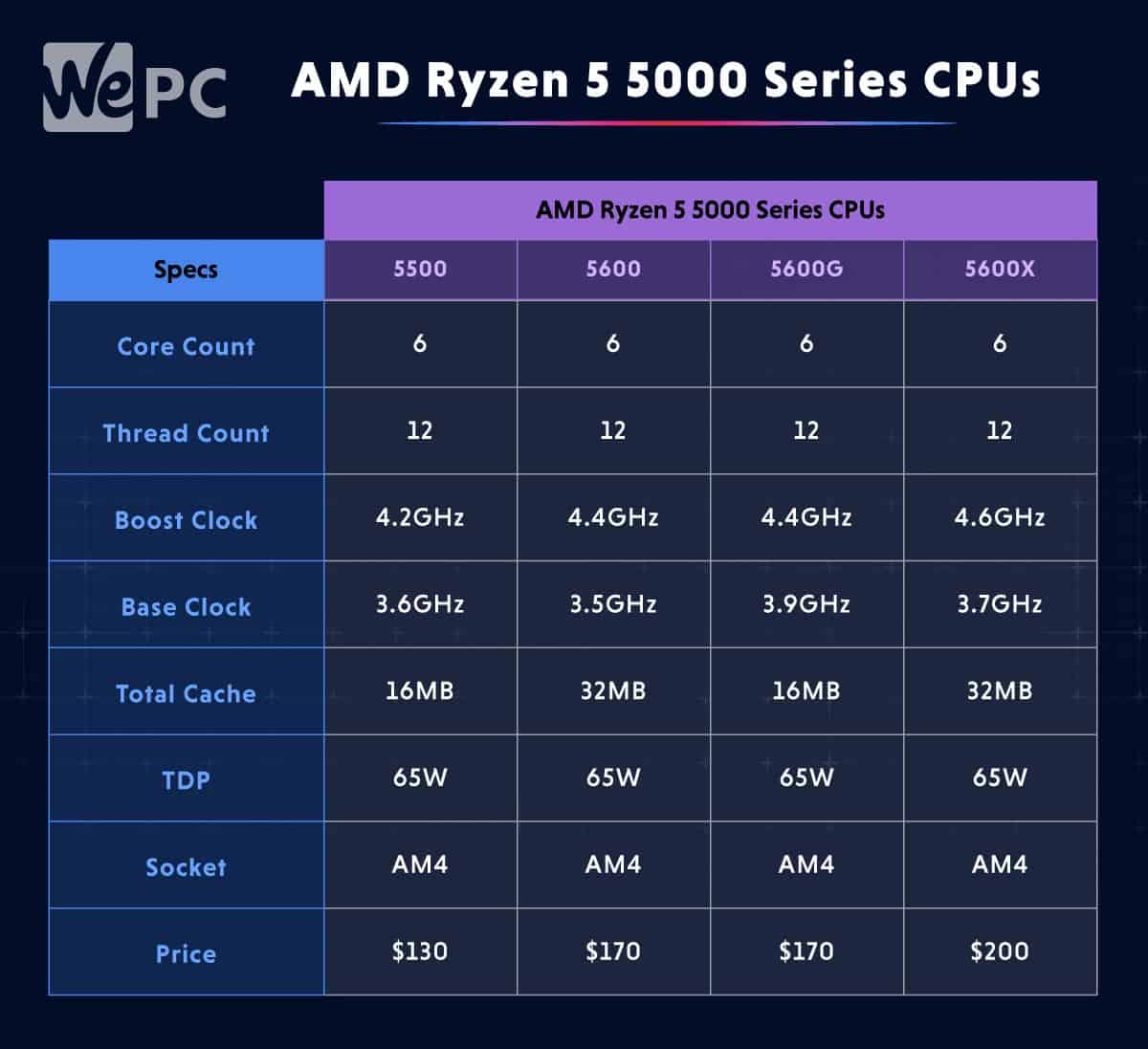
High-performance Ryzen 7 CPUs
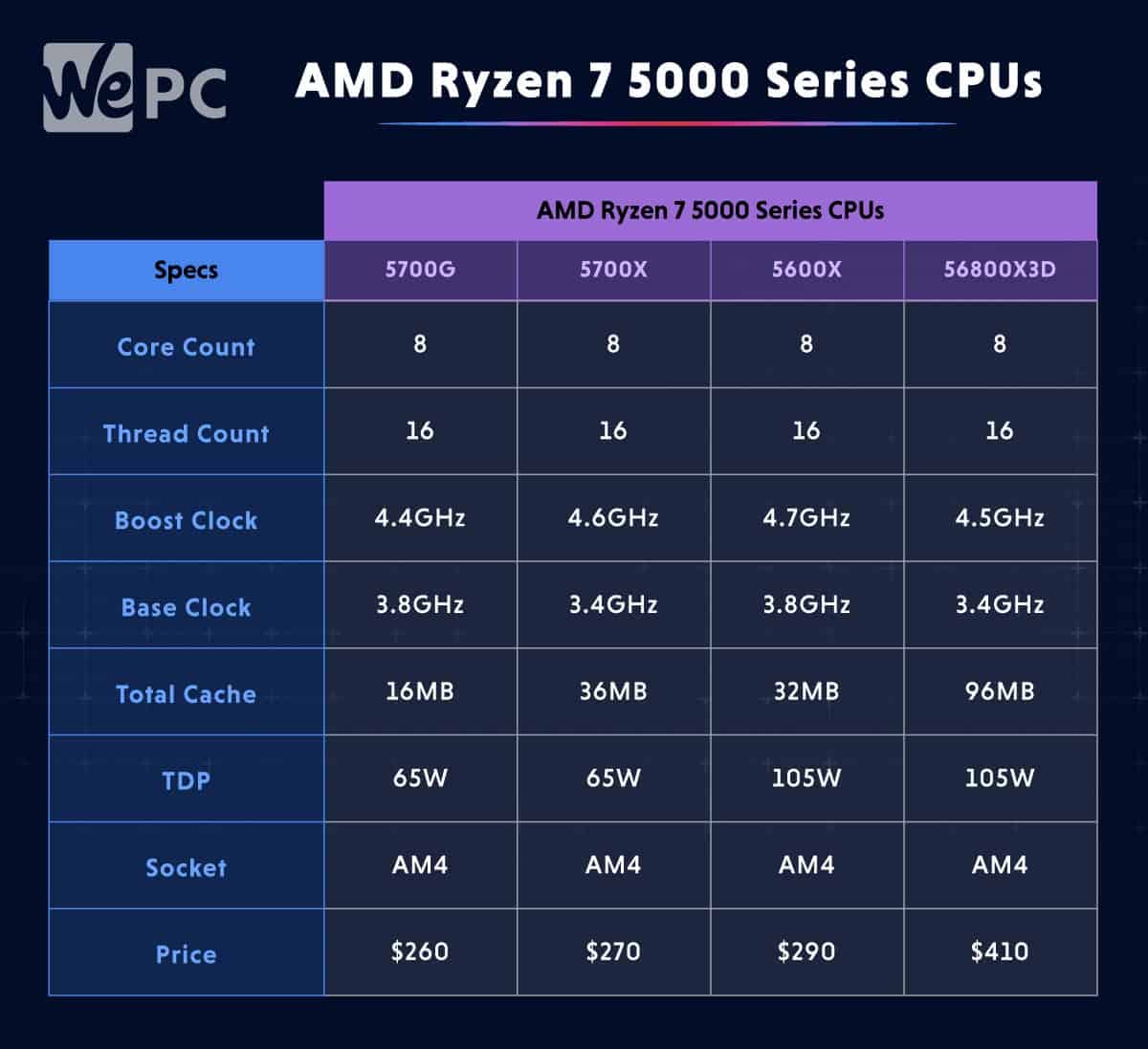
Enthusiast Ryzen 9 CPUs
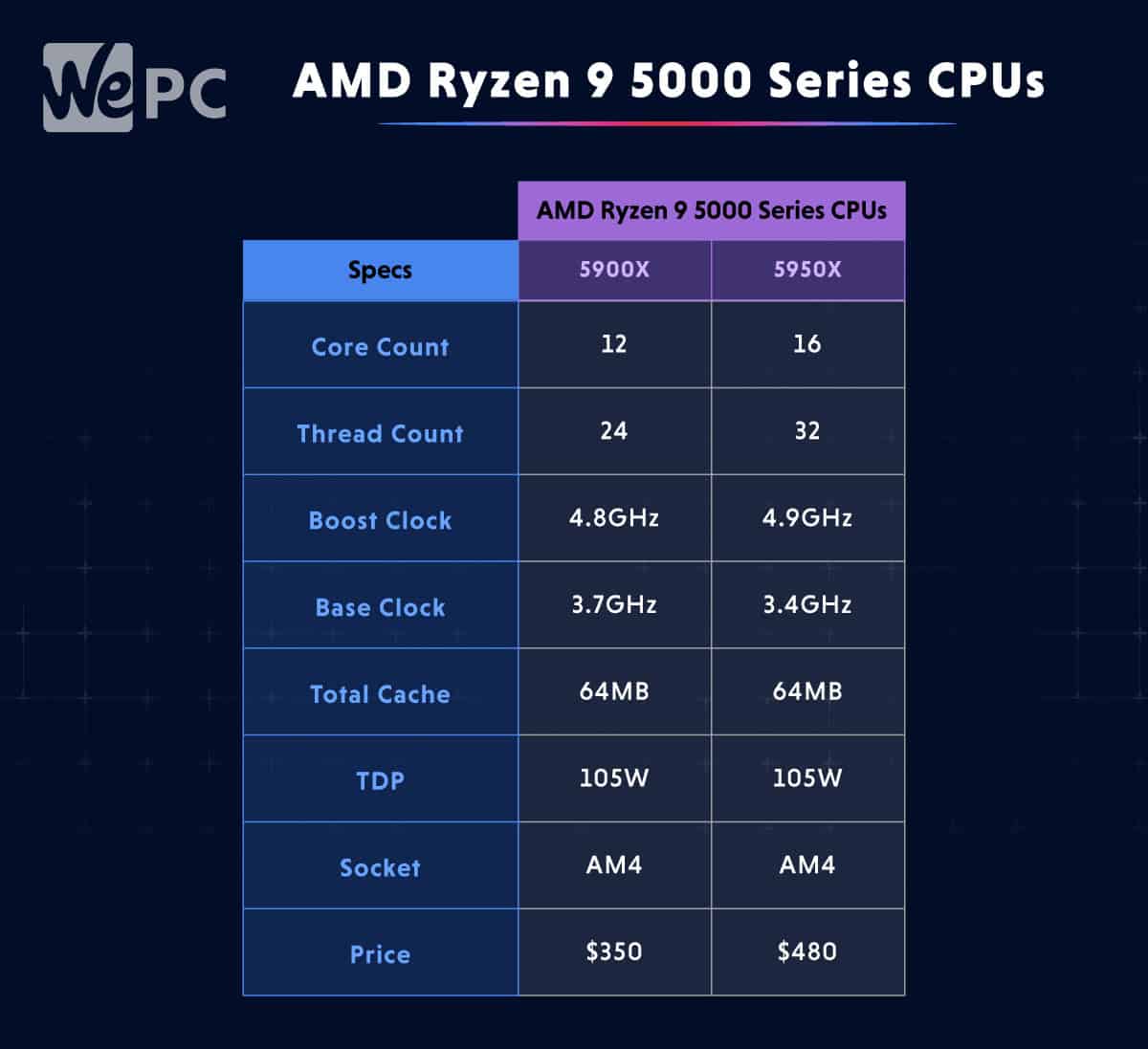
As you can see, the Ryzen 5000 series desktop scope covers less than you might be used to. There are no Ryzen 3 entries, all of those were reserved for OEM only, and there are only a few CPUs in each category.
Something else to note is that every AMD Ryzen CPU is overclockable, but not every AM4 motherboard allows for it.
Intel 12th Generation CPU list.
Below we will list all of the 12th generation Intel CPUs and their prices, so you can get a better idea of how Intel stacks up against AMD, in terms of CPU production.
Entry-level Core i3 CPUs
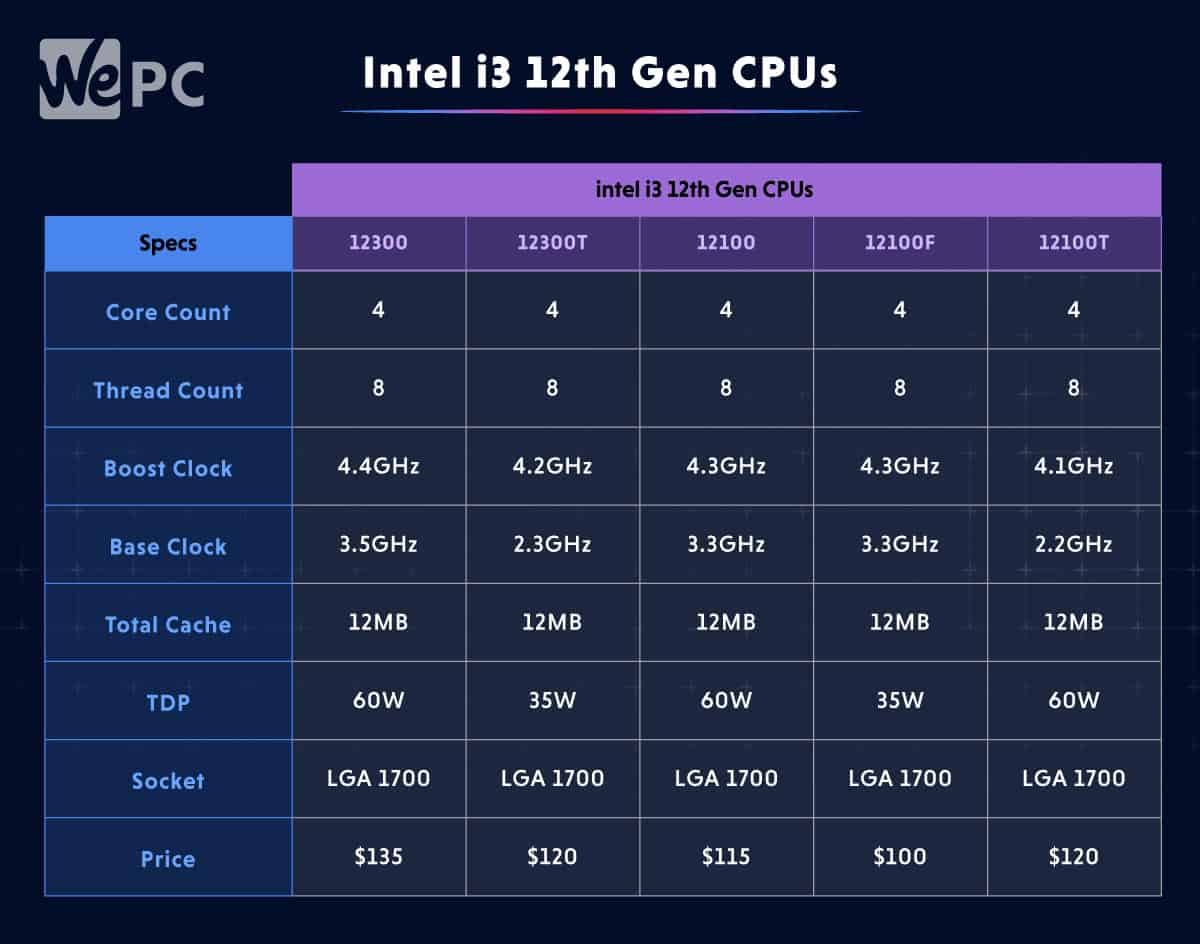
Mid-level Core i5 CPUs
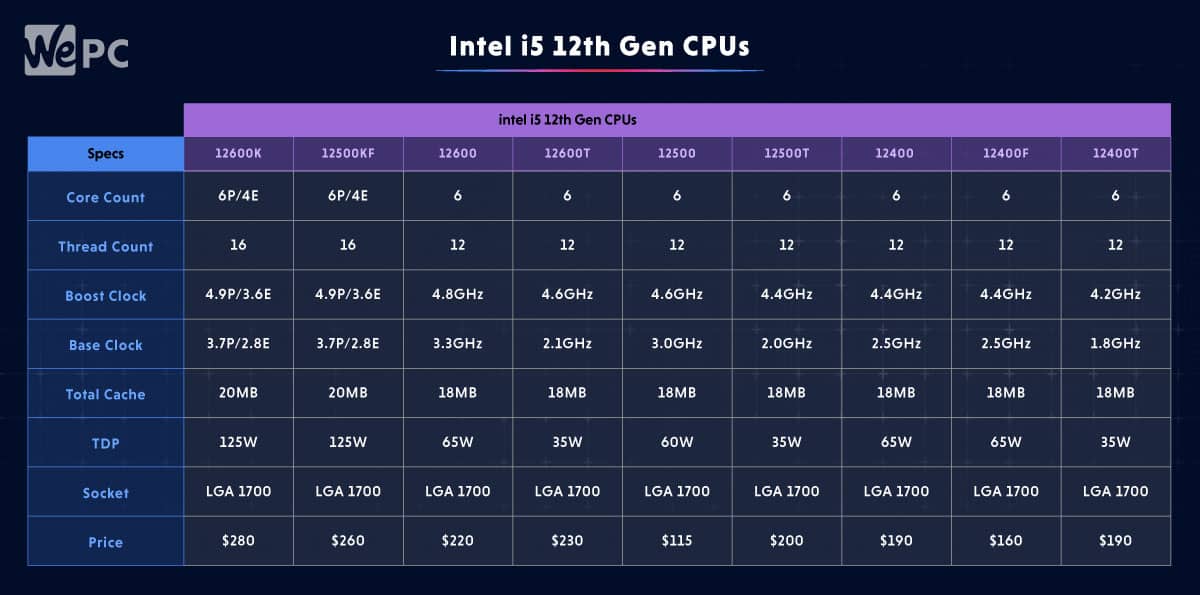
Performance-level Core i7 CPUs
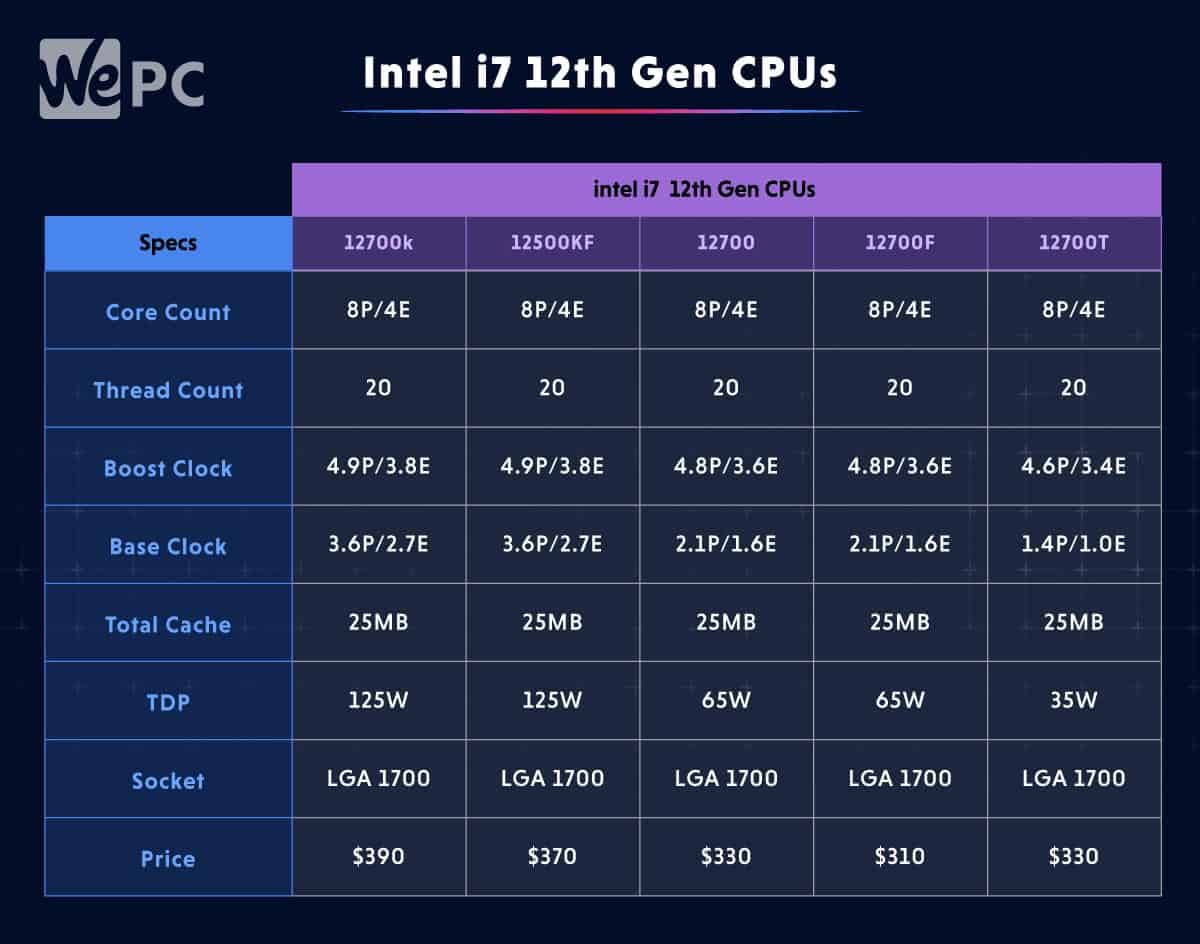
Enthusiast-level Core i9 CPUs
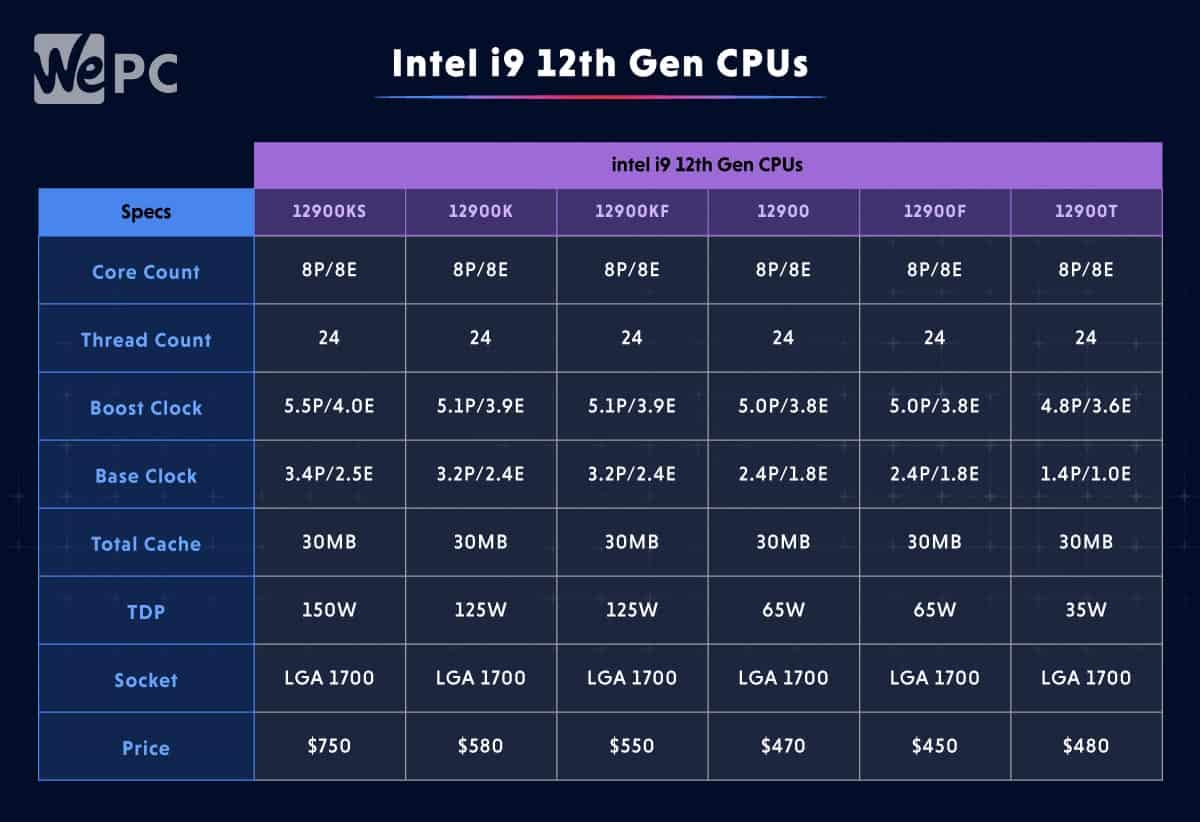
Intel offers a much larger selection of CPUs in every category. Intel includes low-power versions of their CPUs, alongside versions of processors with the iGPU removed – something AMD doesn’t bother with, for the most part.
Intel’s main aim was probably to saturate the market, and leave no space for AMD to cover a piece of the market Intel doesn’t.
CPU identifiers
Both Intel and AMD have CPU suffixes or ‘identifiers’ that help us determine what type of CPU it is, whether that be low power, with or without integrated graphics, or if it’s unlocked for overclocking. These identifiers come in the form of one or two letters at the end of the SKU.
Here are the Intel CPU identifiers.
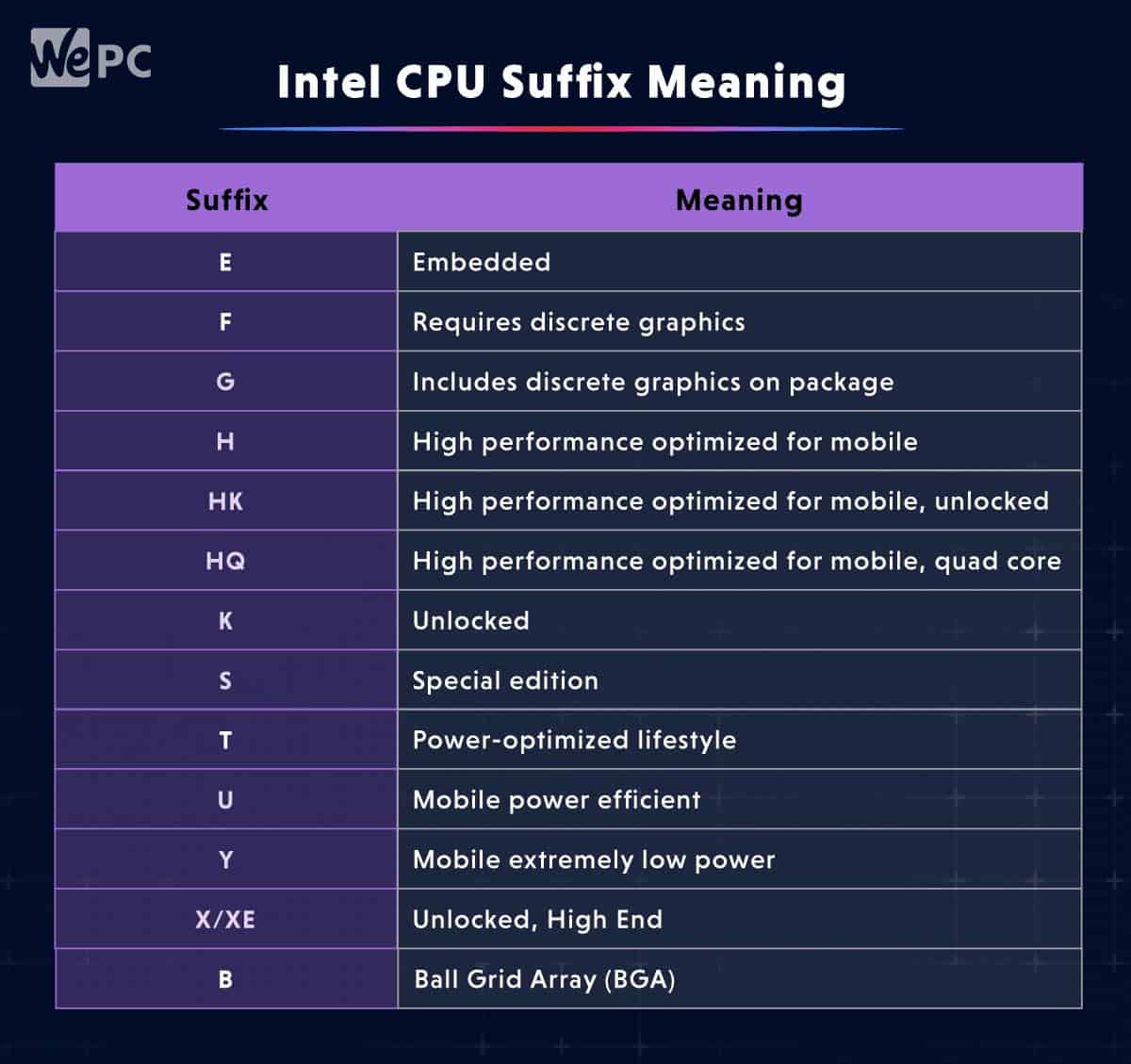
Here are the AMD CPU identifiers.
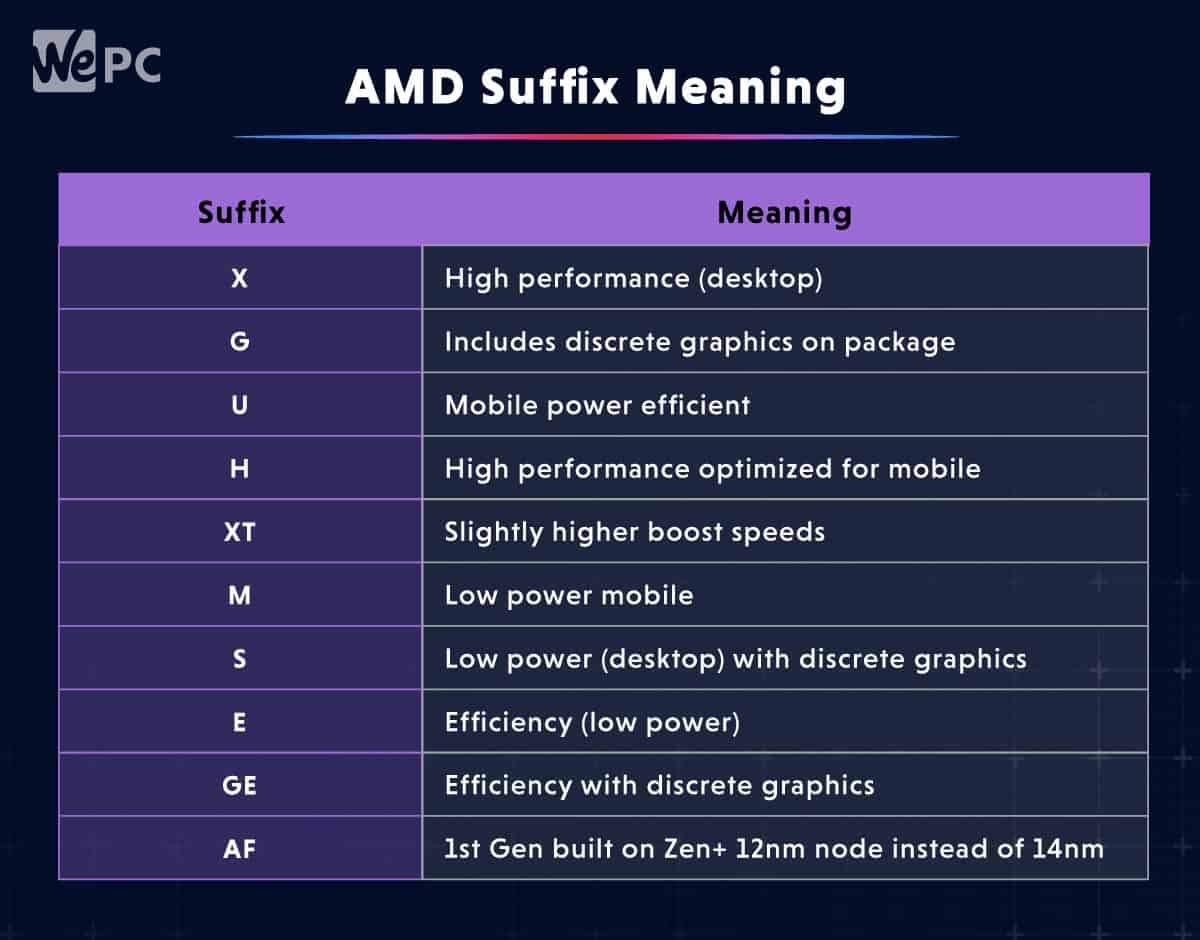
As you can see, there is a multitude of different CPU identifiers – this isn’t even all of them. We only outlined the ones that may still be relevant, even to those of you that have some of the older CPUs. But how does all this equate to performance?
Performance
For the purpose of this article, we have split this performance section into two, gaming performance and workstation performance. CPUs, being multi-core and multithreaded, now have two main areas to focus on in terms of performance – single and multi-core performance.
Single-core performance covers gaming for the most part, and multi-core performance covers workstation tasks, although more and more games are utilizing multiple cores these days.
So, with that out of the way, let’s get into it.
Gaming
We’re basing this portion of the article on data from Primate Labs, the company behind the Geekbench benchmark software.
First of all, let’s cover single-core performance.
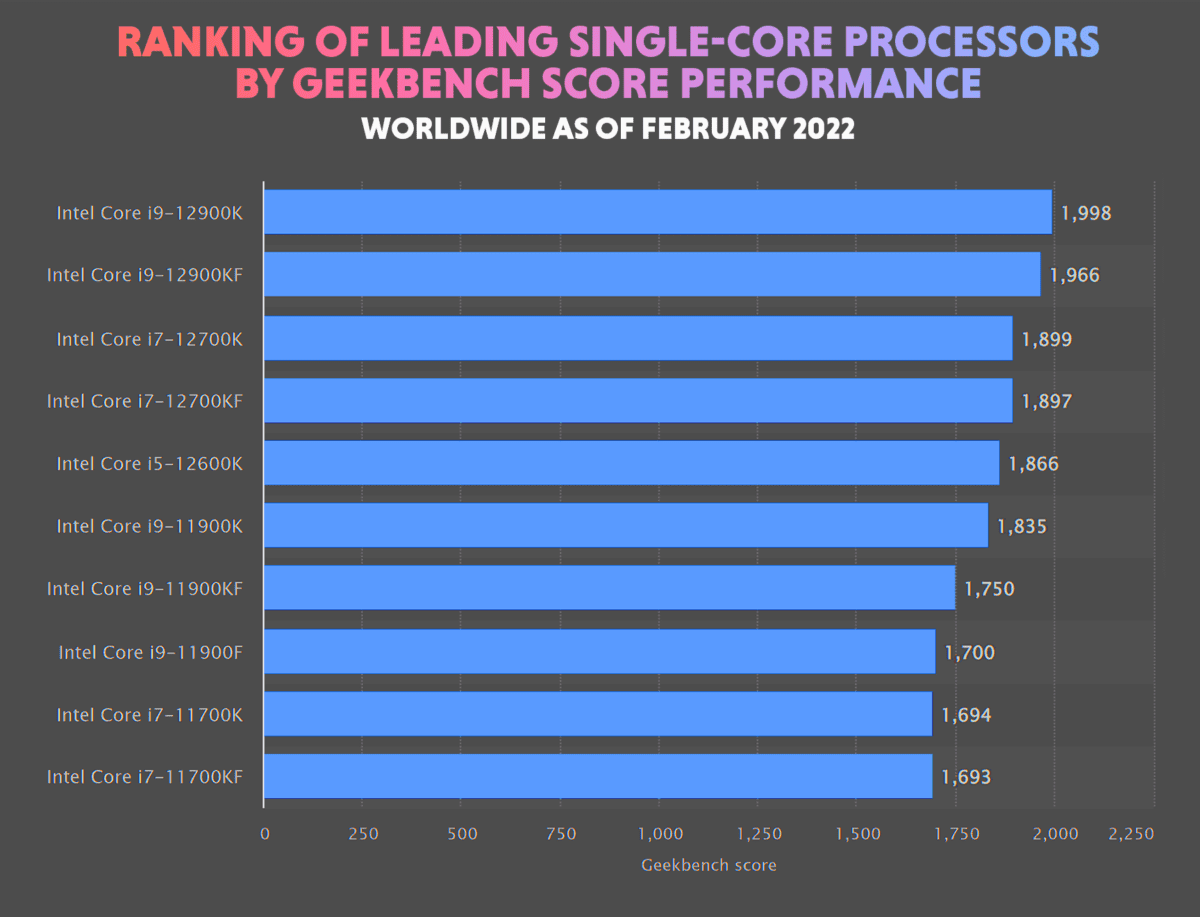
As we mentioned earlier, and as you can see from this graph, Intel still very much dominates the single-core performance scene, with the Core i9 12900K scoring almost 2,000 points in Geekbench benchmarks.
Interestingly enough, our 12900KS only scored 1,998 in single-core benchmarks, but we have no idea what kind of system this data was collated on. But it is safe to say, in our testing, the 12900KS outperformed the 12900K by about 1.36%, cementing the 12900KS atop the leaderboard for the fastest single-core performance in the world.
You may notice that there’s not a single AMD CPU listed here. You may remember us mentioning that AMD isn’t really in the running for great single-core performance just yet, although we expect that to change with the release of Zen 4.
Workstation tasks
We’re again basing this portion of the article on the same data from Primitive Labs, only this time it’s for multi-core performance.
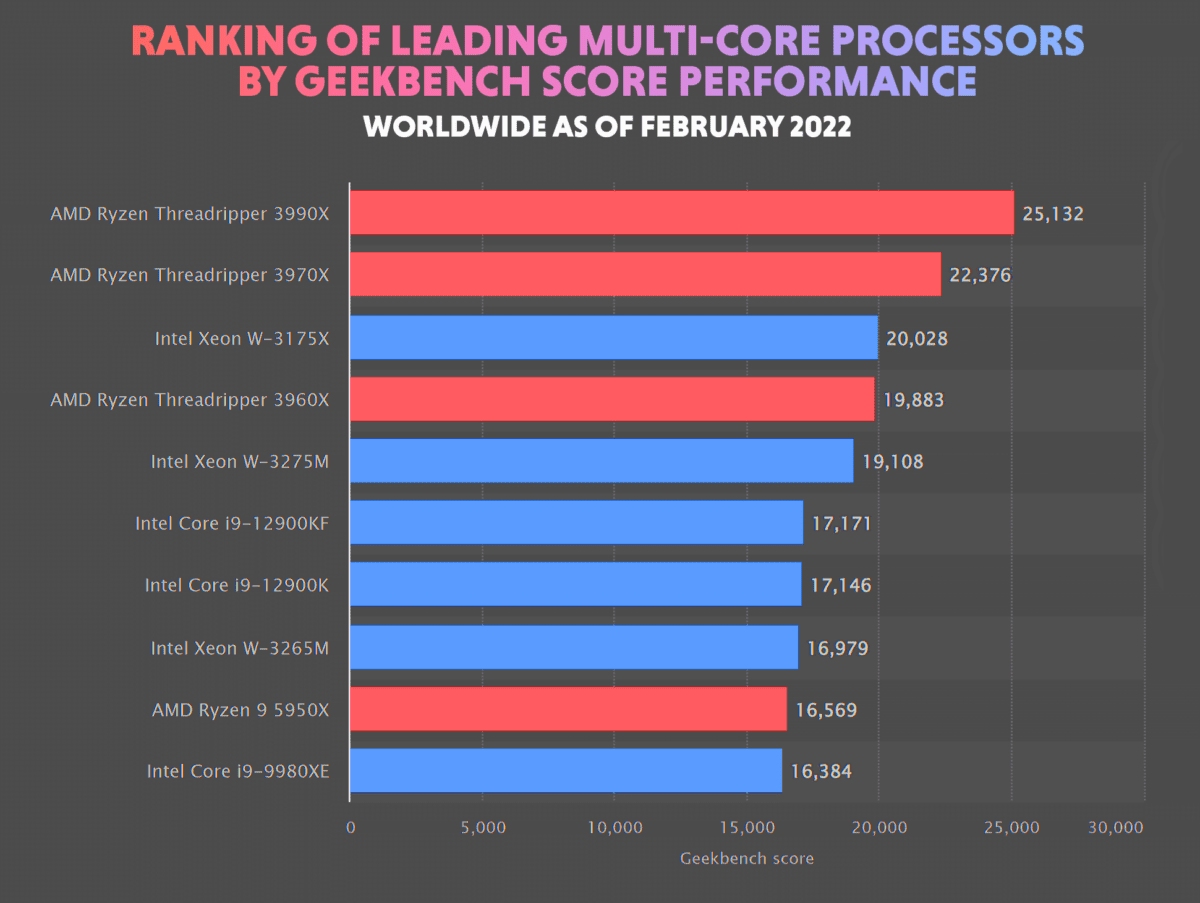
Okay, what’s going on here? What’s a Threadripper? A very valid question, let’s briefly discuss what these new types of CPU are.
Threadrippers and Intel Xeon processors are specially designed workstation processors, designed with a high core count, massive cache sizes, and lower clock speeds. Xeon processors are more geared toward server setups, but the same design principles apply.
Since these CPUs aren’t really gaming-focused, we haven’t touched upon these much at all. In fact, there are multiple types of processors we haven’t discussed. The CPU world is large, vast, and very populated with things the general public never really sees.
Tangent aside, note that these CPUs have up to 64 cores/128 threads, and make a 5950X look like a Tamagotchi.
Observe that a good 60% of this graph belongs to team red, but it’s not just how many AMD CPUs are up there, it’s also the score they lead by.
The best CPU on this list, as of February 2020, is the Threadripper 3990X. This CPU has a full 5,000-point lead over the best Intel can come up with – that is a very impressive lead.
Remember when we mentioned that AMD has multi-core processing locked down? Well, we meant it. We also expect this to change somewhat with the release of AMD’s 7000 series CPUs.
Note: this data is from February 2022, and will be updated with dates from newer CPU releases as soon as it’s available.
Integrated graphics
Whether you’re building a gaming PC or a beefy workstation, you’re probably going to be incorporating a dedicated GPU. However, both AMD and Intel offer CPUs with integrated graphics. AMD refers to theirs as APUs and Intel tends to refer to theirs as “CPUs with iGPU” – catchy we know.
Neither Intel nor AMD’s integrated GPUs are going to allow you to run your games at 4k, as nice as that would be. They are not exactly RTX 3090 Tis.
For the budget-orientated gamer, an APU can be a fantastic place to start, especially since APUs are a GPU and a CPU in one neat package.
That’s all well and good, but which integrated graphics are better?
AMD’s current iGPU component is the RX Vega 8 chip, whilst Intel’s is the UHD 770.
By far the better iGPU component is the RX Vega 8, belonging to the 5700G. When Intel’s 12600K and AMD’s 5600G went toe-to-toe, the 5600G came out with almost double the FPS in some cases.
You have to remember that AMD has been making excellent GPUs for years now, something Intel has only created in iGPU format. That is set to change later this year with the release of Intel’s Arc G
Intel also releases an iGPU component inside nearly every single CPU it manufactures, unless it’s an ‘F’ suffix, something AMD only incorporates into its ‘G’ models.
This makes AMD’s APUs a little harder to come by. Because of this, Intel dominates the GPU market, despite not making a single dedicated GPU.
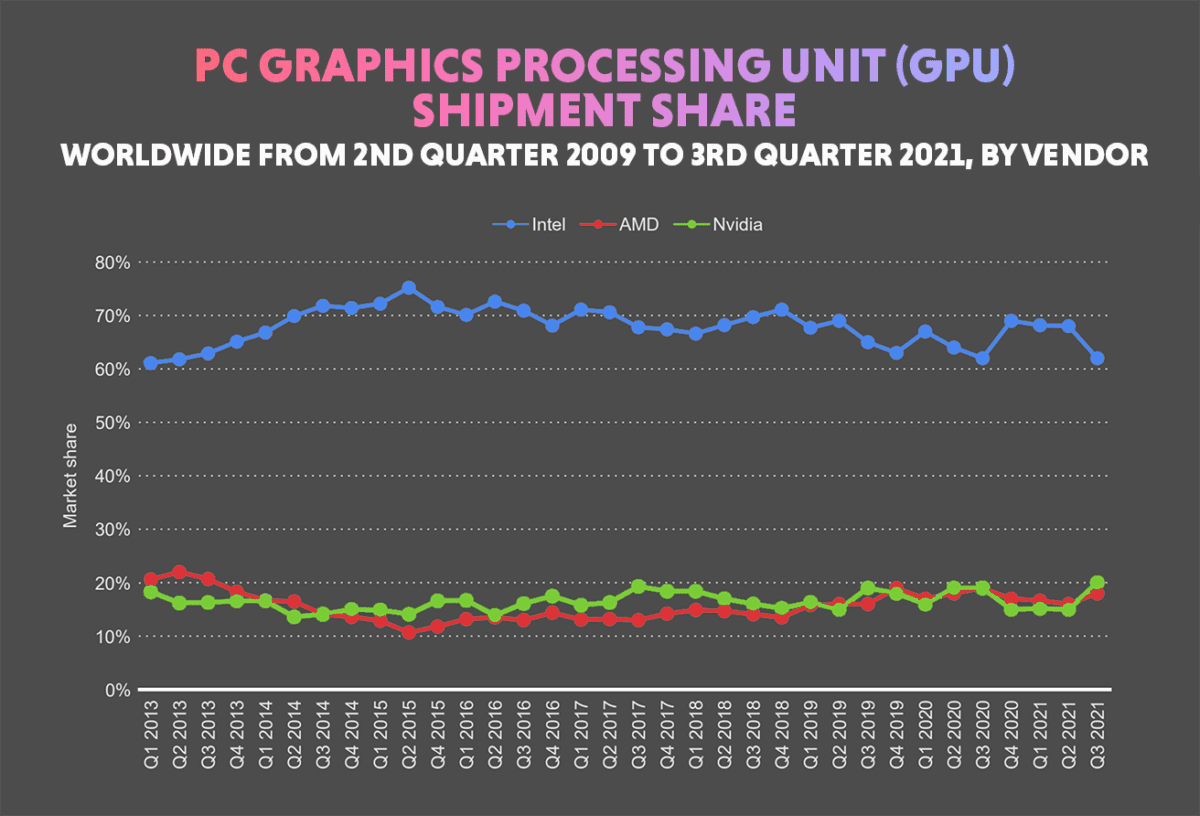
As you can see, Intel holds a majority share of the GPU market, and this came as a surprise to us. We assume this is because of how saturated Intel has made the CPU market. Take a look at how many Intel CPUs were released this generation compared to AMDs – because of this sheer mass of CPUs containing iGPUs designed by Intel, it holds the majority share.
Overclocking
Never before has one word struck so much fear into the hearts of CPU novices, but in this day and age, overclocking is a pretty safe and useful practice.
To understand who and what can be overclocked, we need to refer back to that CPU identifier table we showed you earlier.

You may notice that we only displayed Intel’s suffix table, and this is for a very good reason. Only a select few Intel CPUs have the privilege of being unlocked to overclocking., These are the K, KS, and KF variants – basically, if it has a ‘K’, you’re okay.

Meanwhile, technically every AMD CPU is unlocked to overclocking, except the new Ryzen 7 5800X3D. However, AMD has a special ‘X’ variant that gives you an extended frequency range, which means it’s more susceptible to overclocking. The rest of the AMD CPUs are boosted by AMD’s own PBO (precision boost overdrive).
Overclocking also largely depends on your motherboard, and whether it supports overclocking your CPU – we’ll go more into motherboards later.
Overclocking is safer than it’s ever been before, but that does not mean you can’t damage your CPU or motherboard. Extreme care should be taken when overclocking any of your PC components.
If you want to know how to safely overclock your CPU, check out our ‘how to overclock your CPU’ guide.
Upgradability and compatibility
Here we will explore the potential compatibility headaches each CPU manufacturer brings to the table, and how you could possibly circumvent them. Each CPU manufacturer has a different set of motherboard chipsets available to them, each with its own advantages and disadvantages.
AMD Ryzen compatibility
AMD has compatibility in the bag. After a recent update, AMD has extended the compatibility of most motherboards to accept all Ryzen processors, from 1st Gen all the way to 4th. The exceptions to this are lower-end A series motherboards. We’d recommend you google it first, but whatever AM4-based CPU you currently have, chances are that it will fit into every AM4 motherboard – with a little BIOS update.
This fantastic compatibility can’t last forever, though.
AM4 has been in service for a little over six years, and with it being stuck on PCIe gen 4 and the DDR4 RAM standard, it’s starting to show its technical limitations. This is where AM5 comes in. AM5 is the next generation of CPU sockets, designed for future compatibility just like AM4.
AMD will be making the switch to AM5 with the release of its Zen 4 Raphael CPUs. The respective AM5 motherboards are expected to release alongside the CPUs because, well, it would be silly not to, wouldn’t it? More on this later.
But if you can’t wait until later arrives, you can check out our ‘AM5 what we know’ article.
Intel compatibility
Intel isn’t really the kind of company that builds future compatibility in its tech. Intel, in recent years, has upgraded its motherboards and socket systems for each new CPU release – forcing users to pick up a new motherboard alongside a CPU.
While AMD CPUs needing BIOS updates to extend the compatibility of processors is a little annoying, imagine having to buy a whole new motherboard and rebuild it into your PC every time you want a new CPU.
Whilst LGA 1151 did extend from Kaby lake (7th gen) all the way up to Coffee Lake (9th gen) it’s nothing compared to the compatibility offered by AM4.
Speaking of compatibility, we arrive nicely at motherboards.
The Motherboards
Motherboards don’t really have a huge connection to this article, however, they are important to your CPU. Motherboards affect aspects such as performance, overclocking, and power delivery. So, we’re going to cover the latest generation of motherboards briefly.
Much like CPUs, motherboards are very important to your PC’s operation. The Motherboards are the component that all your other PC parts connect to in order to communicate with one another. Like CPUs, some motherboards are better than others, and they follow a similar set of suffixes or identifiers.
Below are both AMD and Intel motherboard identifiers.
AMD
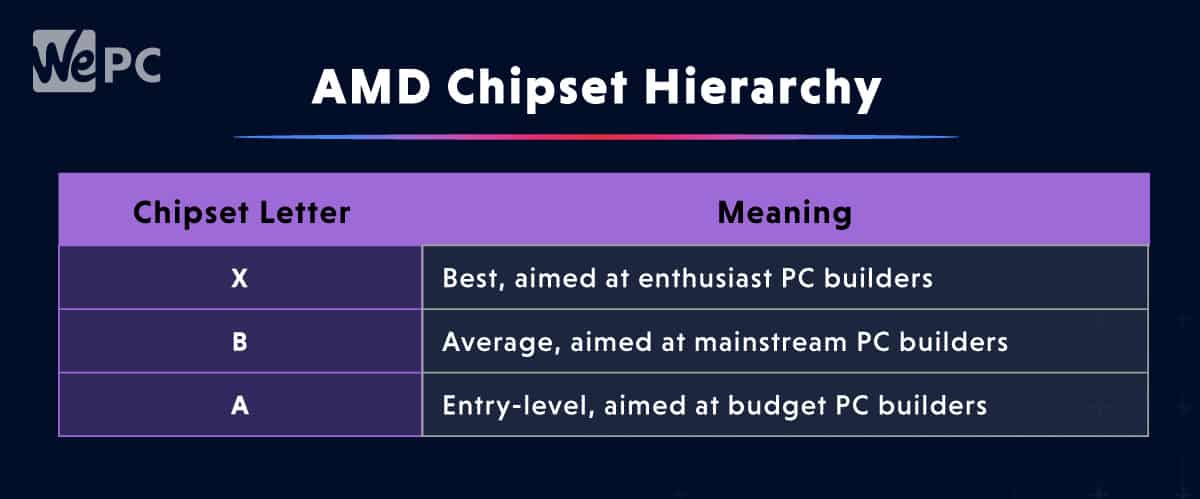
Intel
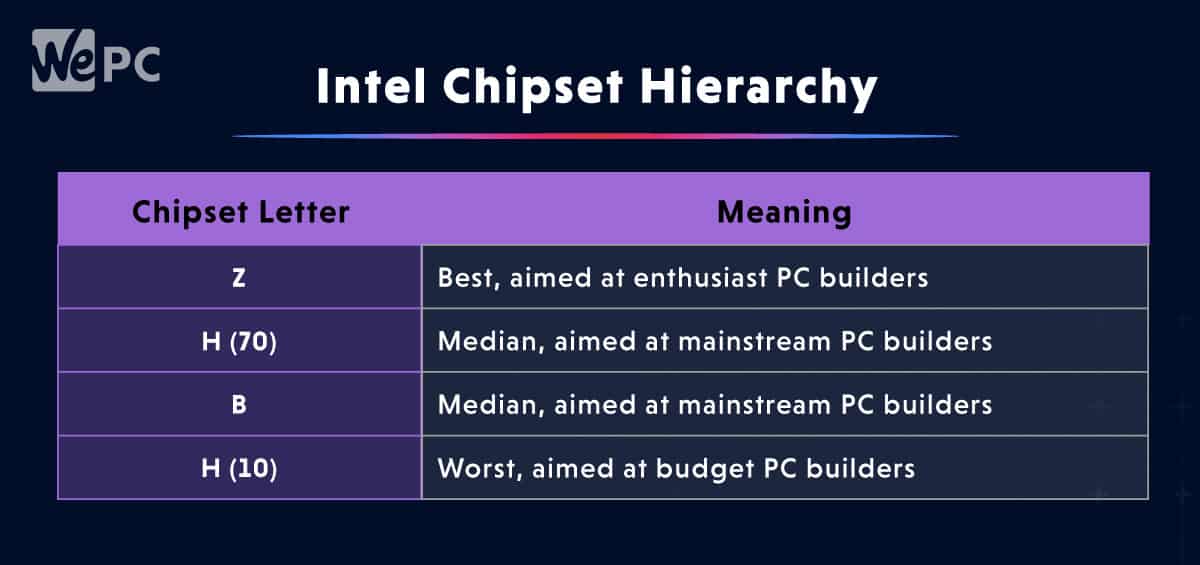
As you can see, Intel is as confusing as ever, using the same letter twice to indicate two different chipset types. Despite the confusing letters on Intel’s part, both manufacturers use a system of letters to indicate how powerful or feature-rich a motherboard is.
Above, we used the word ‘chipset’, but what is that exactly?
Chipsets
A chipset resides on every motherboard and is one of the most important components of a motherboard. The chipset is the device that controls the communication between your CPU, RAM, and other components and peripherals. The chipset also determines how many devices such as USB devices your motherboard can support at any given time.
Chipsets are usually composed of one or more chips that feature controllers for hardware devices and more commonly used peripheral devices, such as keyboards and mice.
If you know anything about motherboards you will have heard the terms X570, Z690, B440, and so on – these are the chipsets. The names can seem confusing at first but all you need to know is that they follow the hierarchy we discussed earlier for both AMD and Intel processors, and the higher the number the better the chipset and the more it will support.
Motherboards continued
Now chipsets are out of the way, we can discuss why motherboards are important.
We will now outline a few examples where the wrong motherboard choice can break a setup.
- Pairing a motherboard with no onboard HDMI port with a 5600G and no GPU.
- Picking up a 9900K for the overclocking potential, and then pairing it with a motherboard that doesn’t allow overclocking.
- Picking up a DDR5 variant of the Z690 for your DDR4 RAM.
We think you understand that there are plenty of incompatibilities you can run into. With technology advancing faster than ever and more components being available to us, it’s imperative you pay attention to the components on hand, and whether or not they are compatible.
The current top-dog motherboards are the X570 for AMD and the Z690 for Intel. If you want to get the most out of your 5000 series AMD CPU or your Intel 12th gen, you should consider one of these.
Below are some of our ‘best of’ guides for motherboards.
Future technology
As of right now, we don’t know too much about Intel’s 13th-generation CPUs, but we do know a good portion of the information about AMD’s 7000 series and AM5.
The AM5 socket is set to replace the current long-standing AM4 socket to house the up-and-coming Zen 4 Ryzen CPUs.
Intel switches its socket type every couple of years whereas AMD kept AM4 in the running for six years but now, it’s time for a change.
A lot of information around AM5 was recently unveiled at Computex 2022.

There are a plethora of new features and technological advancements packed into the new AM5 motherboards, with AMD going all-out to bring us unparalleled support and connectivity for all devices and users.
AMD’s AM5 socket will feature 24 ultrafast PCIe Gen 5 lanes, connected directly to the CPU socket, allowing for ultra-fast connectivity, communication for storage devices, and graphics cards.
AM5 motherboards now also support up to 14 super-fast USB ports, donning 20GB/s transfer speeds and USB type C connectors.
AMD has integrated up to four HDMI 2.1 and DisplayPort 2.0 ports into its higher-end AM5 motherboards, allowing for unparalleled connectivity for the Ryzen 7000 series, which all seem to ship with RDNA 2 integrated graphics.
In addition to all of these features, the AM5 platform will feature an all-new SVI-3 power infrastructure, bringing a multitude of advantages to the AM5 platform. The advantages include additional power stages, fine-grain power and voltage control, and faster frequency response times.
All this is on the new AM5 platform, built upon the LGA socket standard. LGA isn’t anything new it’s been Intel’s system of choice for many years.
LGA 1718
The LGA acronym stands for land grid array and has been Intel’s socket of choice since 2006, but now with AMD making the switch, we thought it would be beneficial to run you through what LGA actually is.
LGA is a socket packaging technology with a grid of contacts called ‘lands’. This differs from the PGA or pin grid array packaging technology that AMD currently uses, as that system is based around pins. LGA reduces the likelihood of damage to the chip either before or during the installation process. This is just one of many benefits to LGA.
We’ll leave that there for now, but you can read more about AM5 and Zen 4 in our articles.
AMD Vs Intel company statistics
Here we will take a look at AMD and Intel’s revenue, year-on-year growth, market share, and a few other things to determine how they’re both performing as companies and not just CPU manufacturers.
The following data comes courtesy of macrotrends, and details of both AMD and Intel can be found here:
AMD
First up under the microscope is AMD.
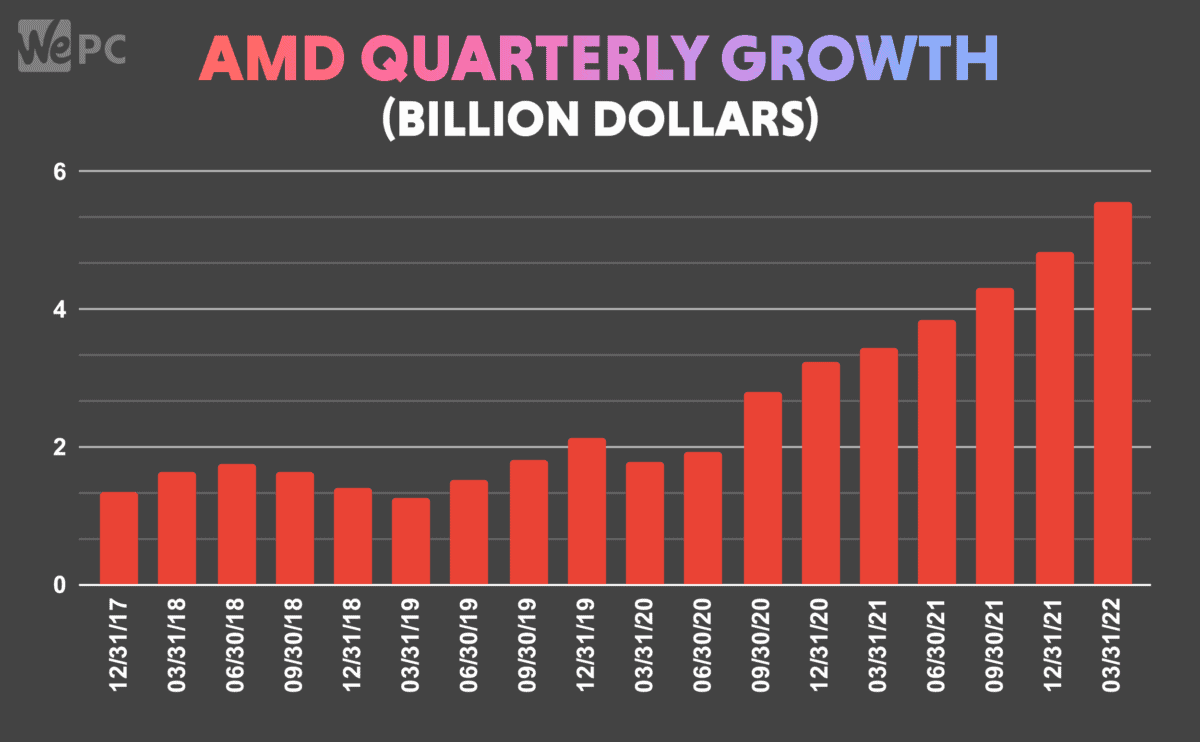
AMD has been on the rise since 2017 in terms of revenue. In 2017, AMD earned annual revenue of $5,253 (millions of US$) and grew exponentially to a revenue of $16,434 in 2021, an increase of 212.85% over four years. AMD has since been able to sustain an average YOY quarterly growth rate of about 50% from 2017 until 2021.
Although we don’t have full numbers for 2022, as we’re only halfway through it currently, we do have AMD’s first-quarter revenue for 2022. AMD’s first quarter stands at $5,887, a record-high number for AMD.
Intel
Here’s Intel’s revenue and YOY growth.
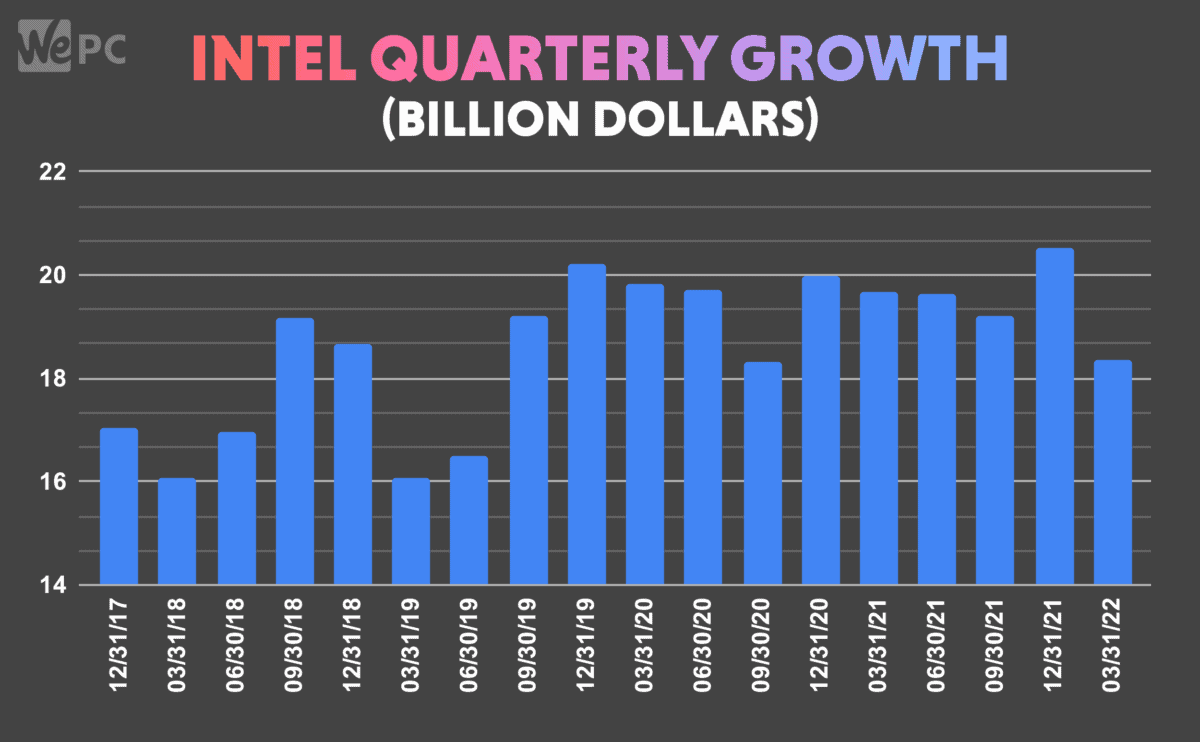
Intel right off the bat brings in much larger numbers than AMD. Intel, in 2017, earned annual revenue of $62,761 (millions of US$) and in 2021, it brought in a revenue of $77,070, meaning an increase of 22.79% for the company over four years – much less than AMD’s growth.
YOY growth of Intel is a little unsteady, with half of 2019, 2020, and 2021 seeing year-on-year decreases of around 1% on average over the three periods.
Again, we’re only halfway through 2022, but in Intel’s first quarter of 2022, it netted $18,353 (millions of US$), nowhere near a record high for the company. Intel’s best quarter came in the third quarter of 2021 with a revenue of $20,528
Intel VS AMD
Here we will analyze both AMD and Intel’s revenue numbers and compare them.
Revenue
When comparing the two companies in terms of revenue, they are completely different beasts. Intel brings in magnitudes more than AMD does and at first, it might be hard to understand why.
Intel only offers CPUs, right? Well yes, and no. The reason Intel makes so much money compared to AMD is the fact that Intel has completely saturated the market in terms of CPU numbers.
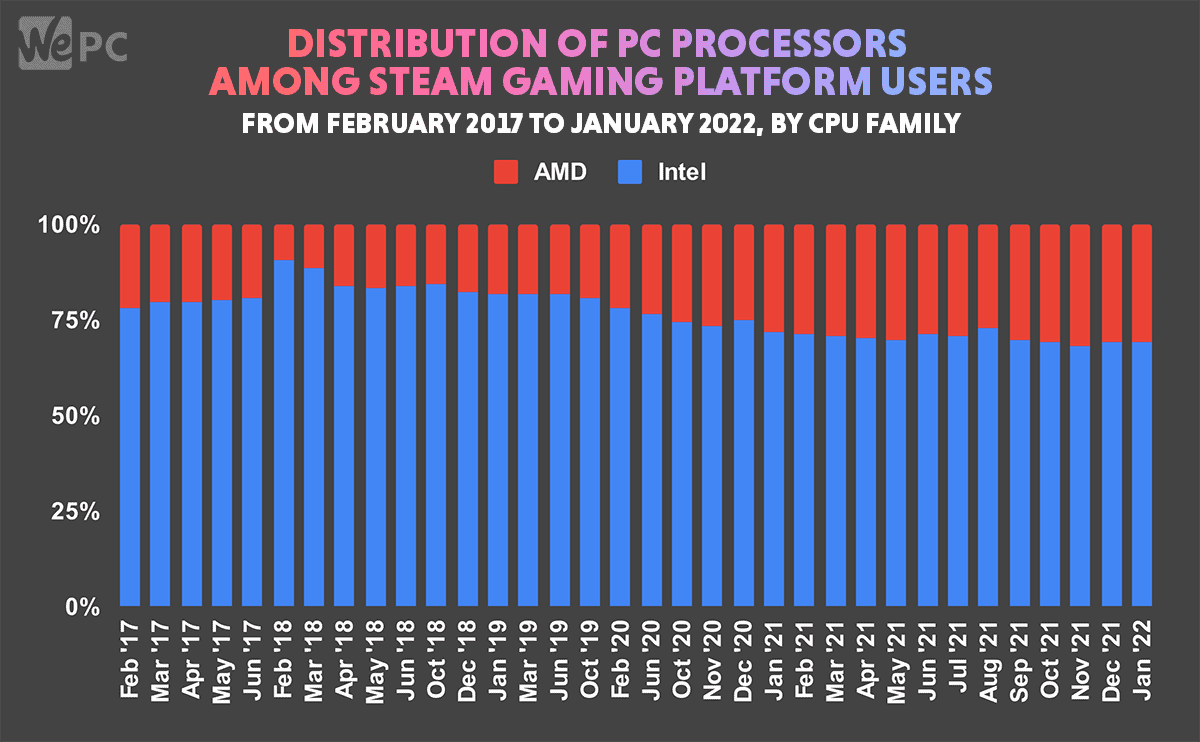
Following the Steam hardware survey, we see that in February 2018, 90.91% of people that used Steam had an Intel CPU – that’s 90% of Steam’s reported 18.36 million concurrent users that month.
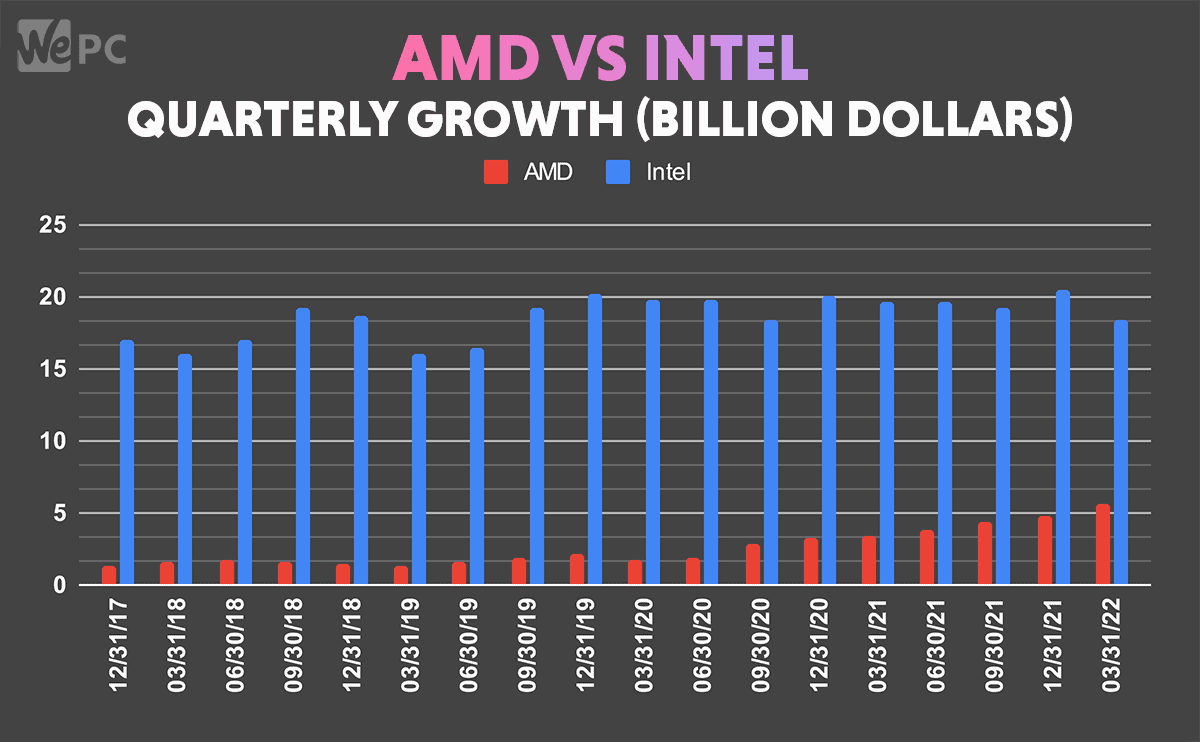
This translates well to revenue. Intel’s revenue is greater than AMD’s because of Intel’s hold on the market – that is changing, however. AMD is creeping closer and closer to Intel. Even if it seems like they’re still a million miles away, they’re in a much better position thanks to the success of Ryzen, and deals involving EPYC server solutions.
In recent years, AMD CPUs are becoming more and more popular in the eyes of consumers, thanks to amazing technology and hard-to-beat prices. The below chart shows the sales of both AMD and Intel CPUs through German retailer Mindfactory.
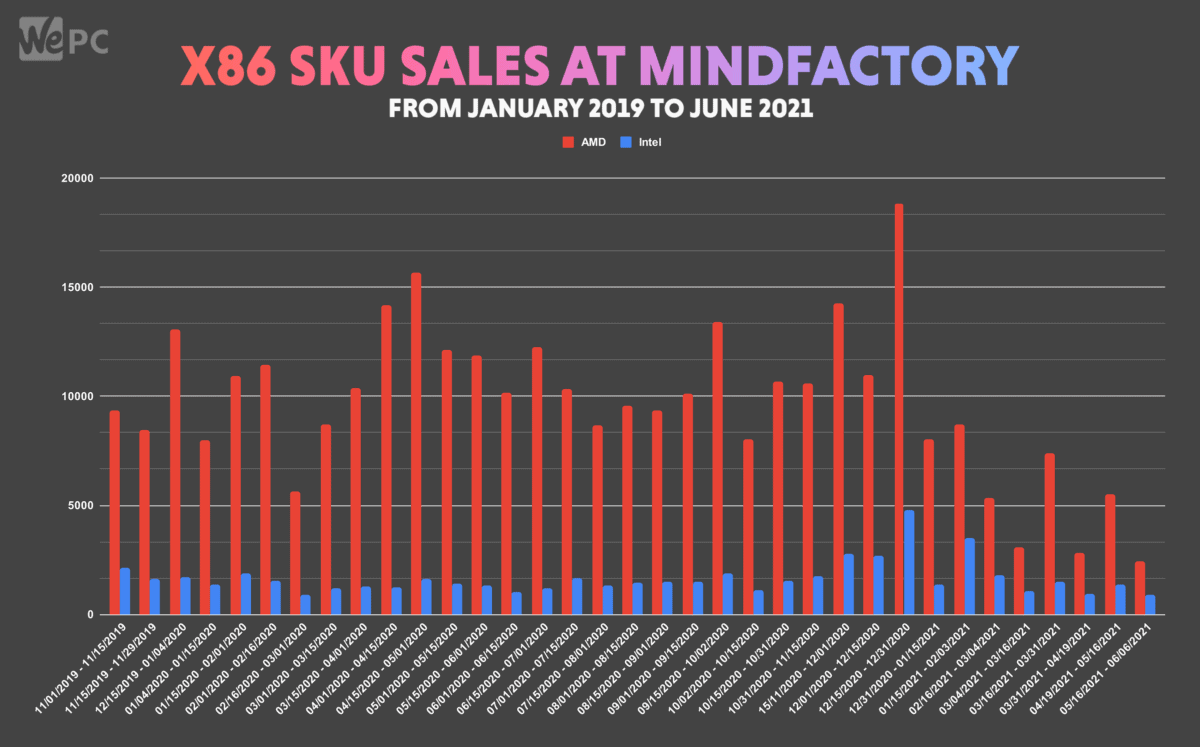
As you can see, AMD has been dominating the market in terms of sales for the last few years, selling thousands more CPUs every month than its competitor. We know this is only one retailer, but it does reflect a global trend. The fact of the matter is, people, love AMD and if it wasn’t for the stock shortages around the launch of the 5000 series, we feel AMD would be in an even better place.
AMD VS Intel: Market share
This data is a little old now, but we are waiting for updated information. The older data goes to show just how far AMD has become in the last few years, since the release of Ryzen CPUs.
We see AMD and Intel processors used in desktop PCs, laptops, tablet computers, and servers. Now, while Intel has been the market leader in the CPU realm for a long time, AMD hasn’t stopped growing in strength, especially since the latest CPU architecture release.
From 2014 to 2018, Intel’s revenue grew from $55.9B to $70.8B, and AMD’s from $5.5B to $6.5B. Despite the dominance of Intel, both companies saw a very similar average revenue growth rate of 6.2%(Intel) and 6.4%(AMD).
So, where is the revenue coming from?
As you can see from these figures by Trefis, both manufacturers’ primary source of revenue comes from China, with the US only accounting for half as much for both Intel and AMD products.
AMD VS Intel: Final word
So, who is better? Well, technically speaking it’s Intel. Intel has dominated the CPU market for a very long time and continues to do so, regardless of the fact AMD is slowly gaining on them – winning is winning.
Who makes the better CPU? Now that is a good question, one we feel should be answered with another question – what do you need the CPU for?
If the answer is single-core performance then it’s a resounding Intel. Intel has single-core CPU performance on lockdown, and it looks like that reign may only be ended by Zen 4. For now, though, Intel does the single-core performance better.
However, if you’re looking for some weight in the multi-core performance area, then you need to pick up an AMD CPU. Multi-core workloads include gaming too, as we mentioned earlier. AMD managed to snag the title of fastest gaming CPU with the 5800X3D, a pretty impressive feat when you consider what it’s up against and the limitations placed on it.
What about the future? AMD seems to have an incredibly promising future, as recently a Zen 4 engineering sample was leaked reporting an all-core boost speed of 5.21GHz, and boasting RDNA2 GPU capabilities. We already know AMD’s integrated graphics are much better than Intel’s and achieving an all-core speed of 5.21GHz is very impressive, engineering sample or not.
The battle for dominance between AMD and Intel is far from over, but now the ball is in AMD’s court. What will Zen 4 and AM5 bring? We hope to find out soon enough.

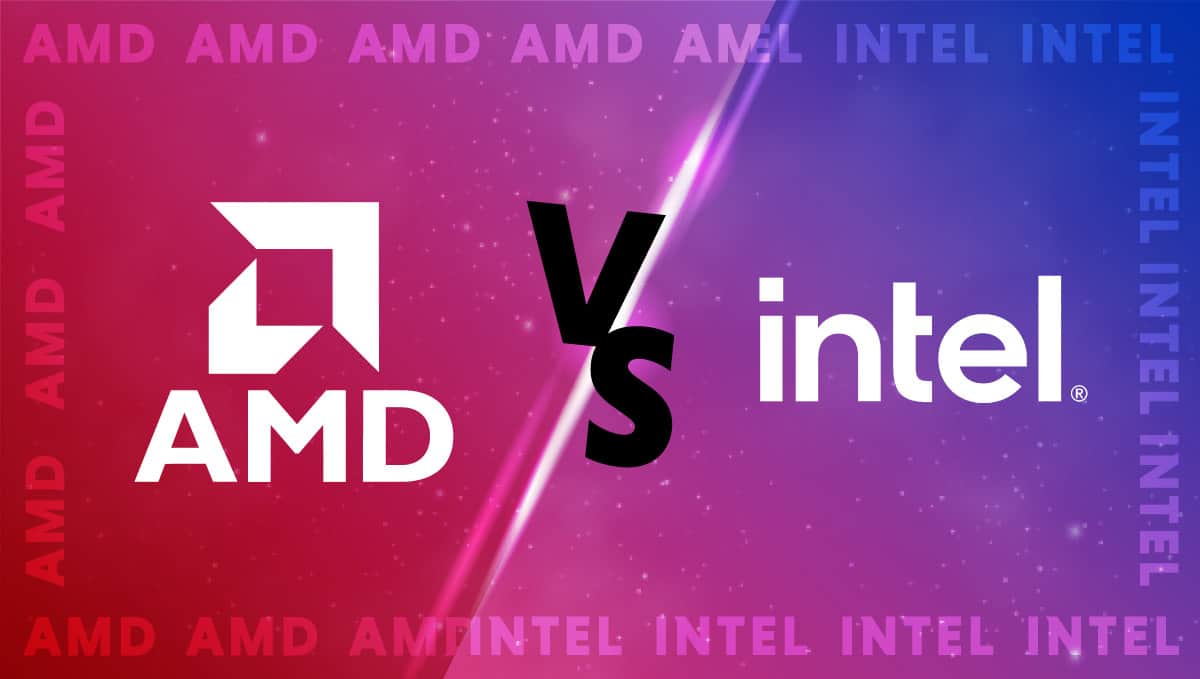
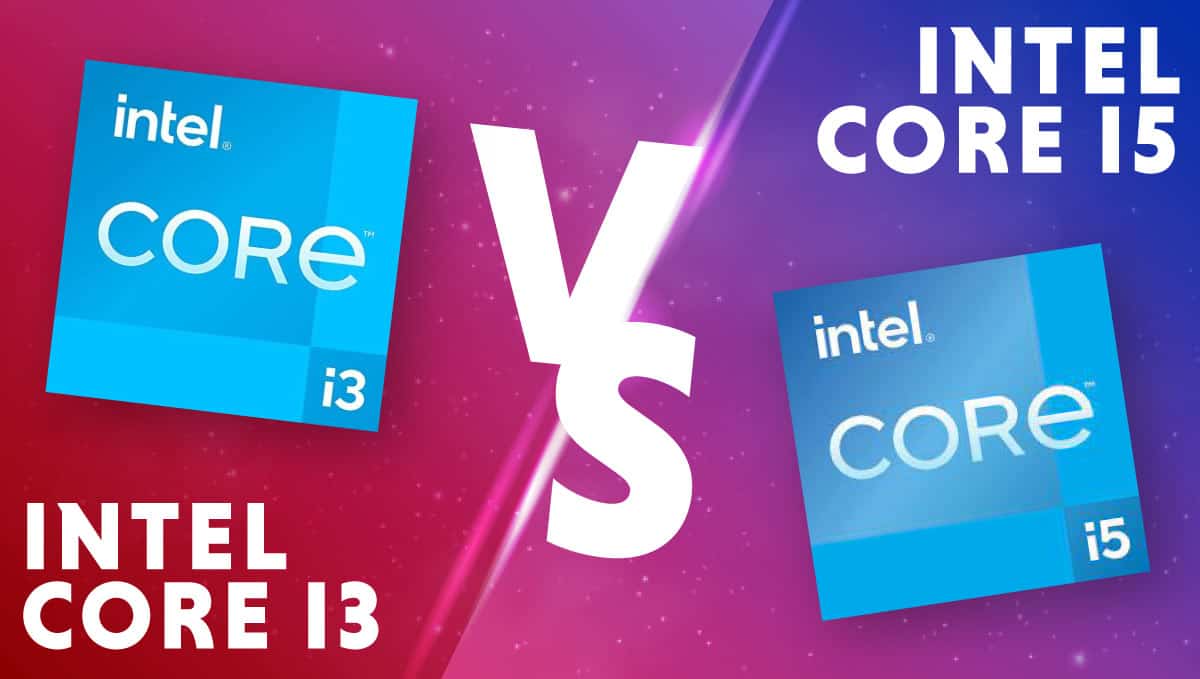
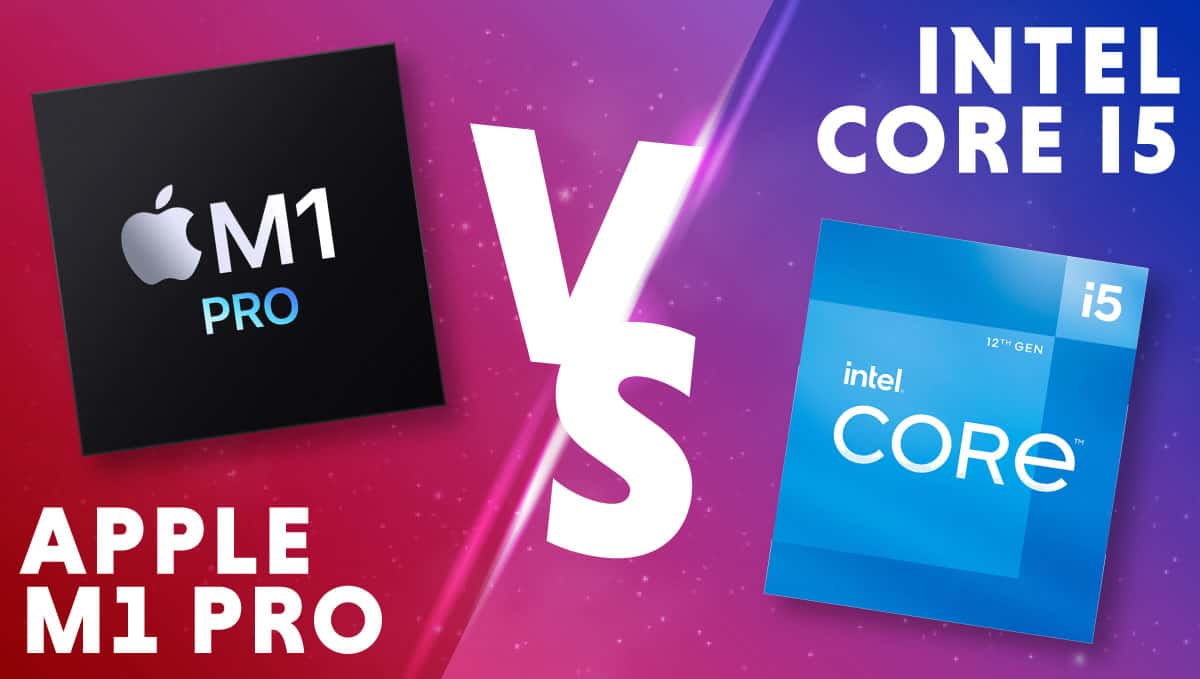
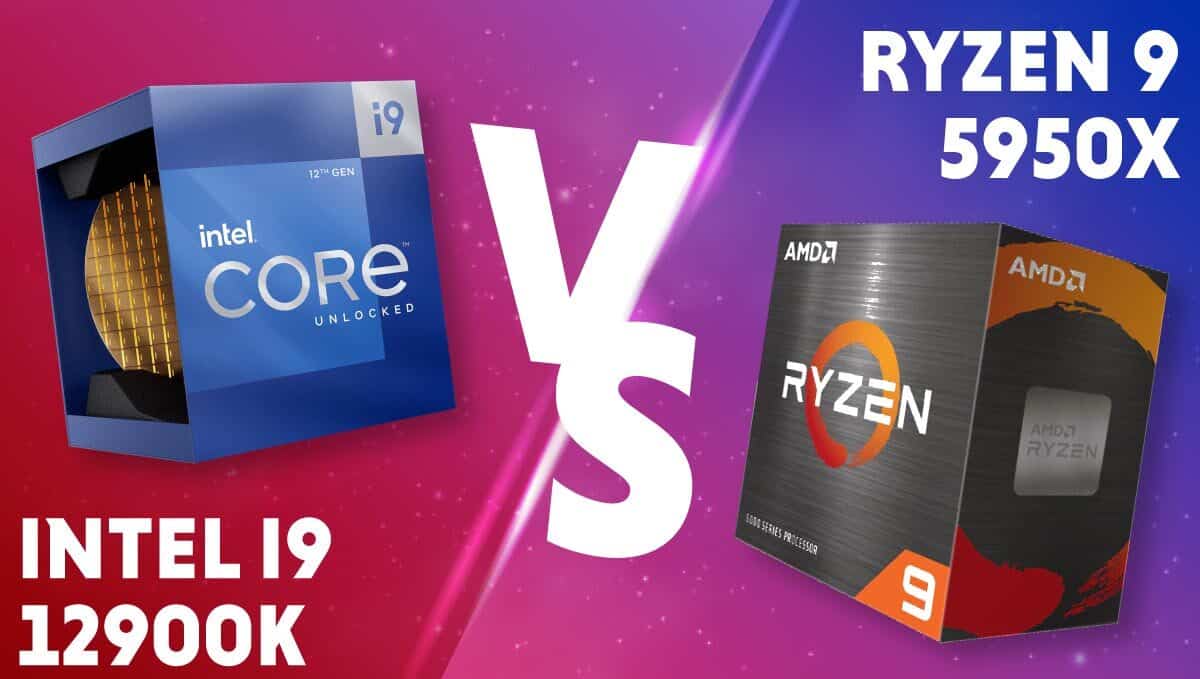
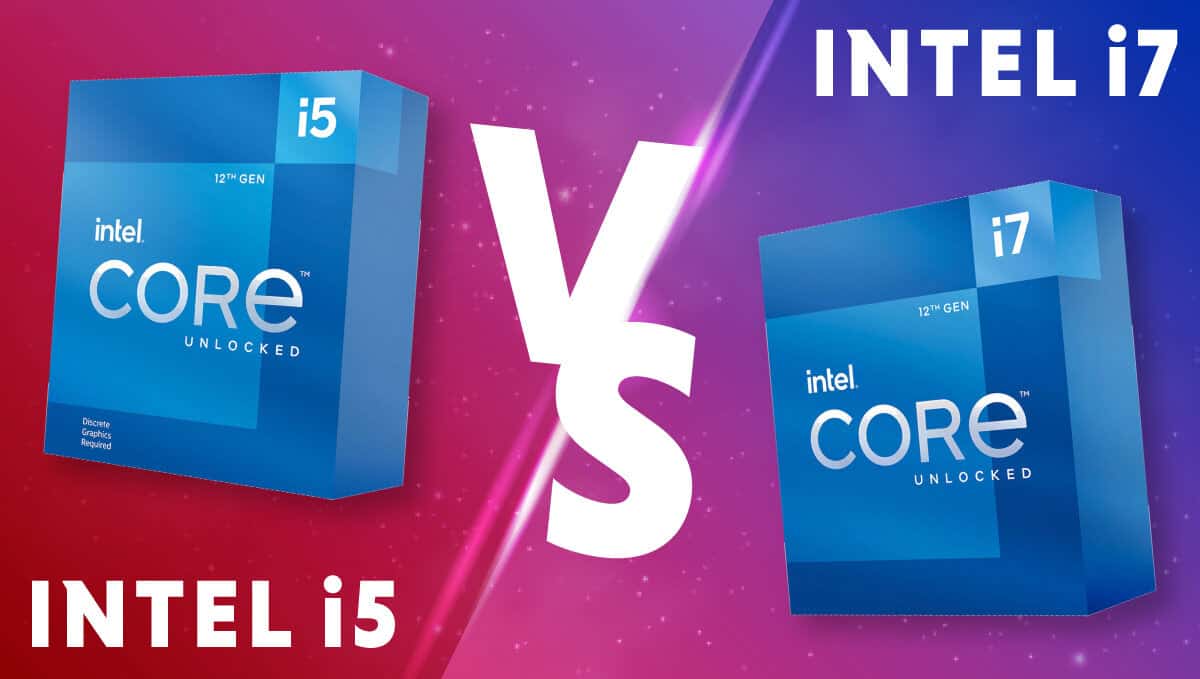
Shaun, thank you so much. I’ve been scratching my head for days trying to work out where to start and how to approach my first pc in 6 years.
This article has been the best resource I’ve found. Your approach, terminology and explanations were amazing. I actually don’t feel confused anymore:
I’ll be catching more of your articles.
AMD is defeat
Which would be better for gamming and maybe graphic design
Hi
I want assemble PC for heavy engineering design and simulations.
may i ask you witch one is better: AMD or Intel
AMD is definitely the one to go for Amir.
Hi there masters! May I ask for some gaming pc specs for the upcoming 2020 games like FF7 Remake, Nioh, Res Evil, etc. ?
Thank you very much Mr. Shaun this helped a lot
Can i use amd for programming, animation and making games
Hi Shoaib, Yes. For CPU intensive tasks that require numerous cores, AMD are extremely good.
Good article. That being said, you might want to go easy on the canned phrases. 🙂
Which is better intel/AMD for Gaming PC…Please suggest and help me..!
Hi Tamim, thanks for the comment. Technically Intel is still the better option for just gaming thanks to the strong single-core performance and a higher base clock.
That being said, AMD offer much better value for money so if you were planning on using the computer for more than gaming, I would say go down the AMD route.
Which would be better for gamming and maybe graphic design
Curious why you excluded the Intel 9th-generation CPUs from your charts, they’ve been out for months.
Hi Jon, this is due to be amended shortly and the CPUs are being brought up to date.
This is hands down the most well condensed and informative article on this topic I’ve ever been able to find. Finally all of the information in one article in a fashion I can understand without rereading 3 times. Great article, brother! Keep the dream alive!
Hi Matthew, thanks for the comment. Really great to hear this has helped you, what CPU did you go with?
I found this at 5am and read everything. Thank you so much for taking the time to write this as I know absolute f all about computers and this was super informative! My last computer died in 2012 and prior to that when I built my first computer I literally bought anything and put them all together haha. But anyway, thanks again.
Glad to hear this helped Aaron. How is the new build treating you?
“Note – All listings are current at time of article release (July 2019)”
Wow, an article from the future
No time travel just yet!
so, the amd wons from the gaming world
Intel is better in gaming bro
Intel is still a bit better for gaming yes. But the value and benefits from the AMD chips is excellent and really makes it a negligible difference.
For Gaming, AMD cpu’s has more 1% and .1% low difference as compared to intel which means you will notice very small amount of lagging in the gaming and that is not the case with intel.
Looks like Excel messed your charts (cores-threads 12-Jun)
Hi Tapiov, good spot. We will be sorting this out today.
It indeed helped me a lot, thank you! 🙂
No problem Serylt!